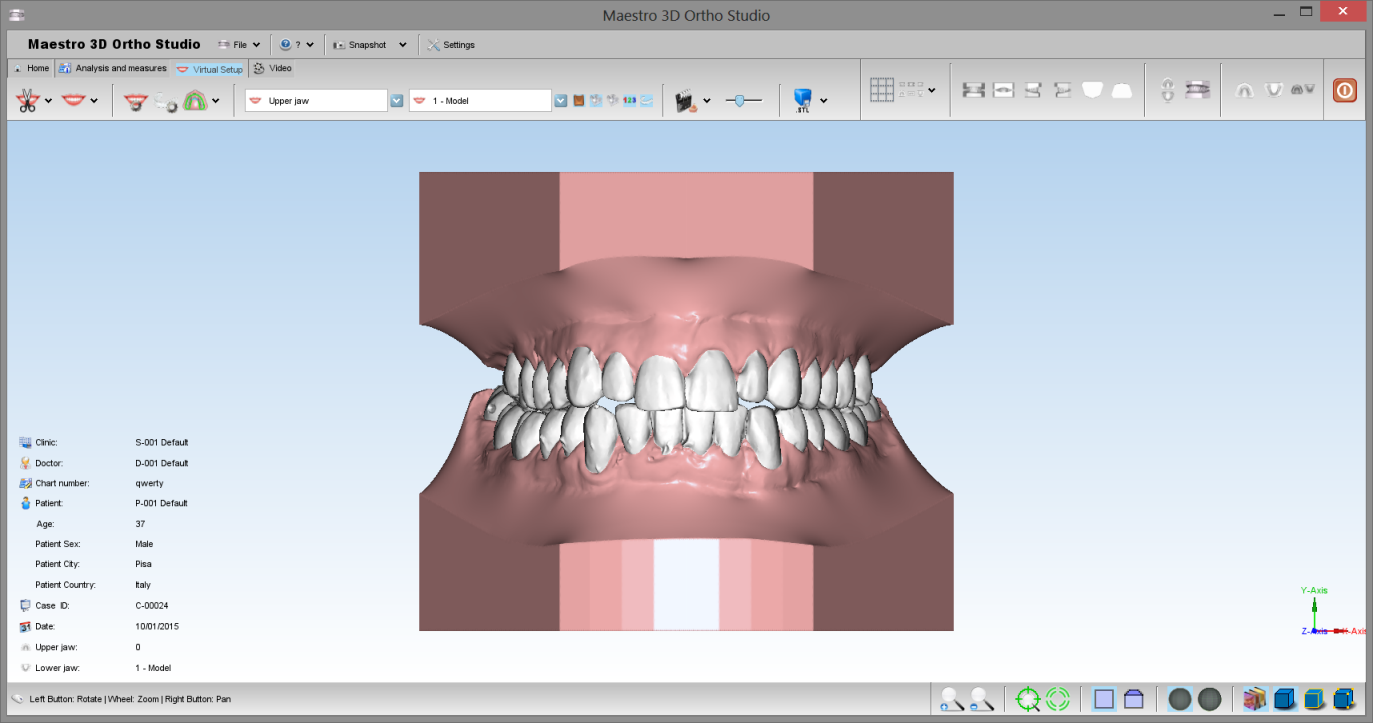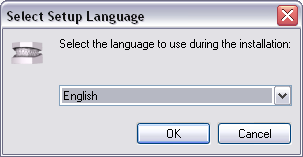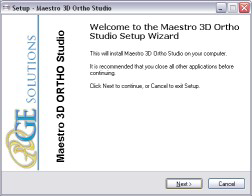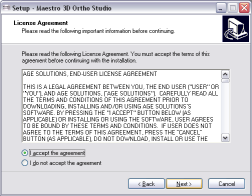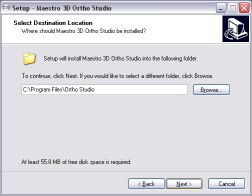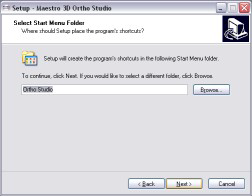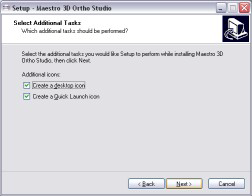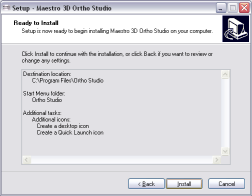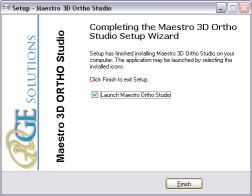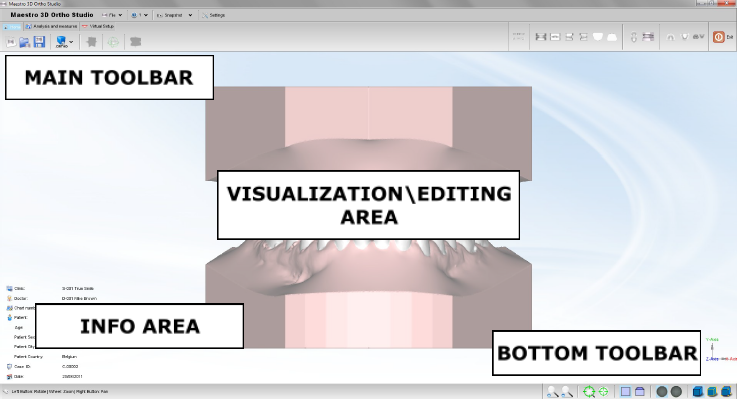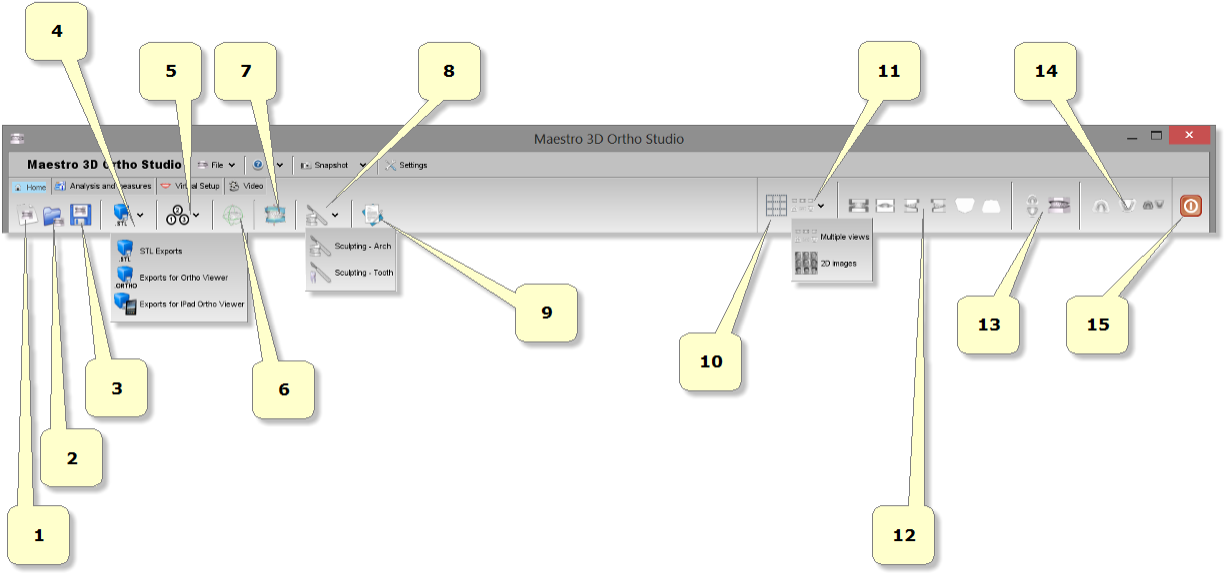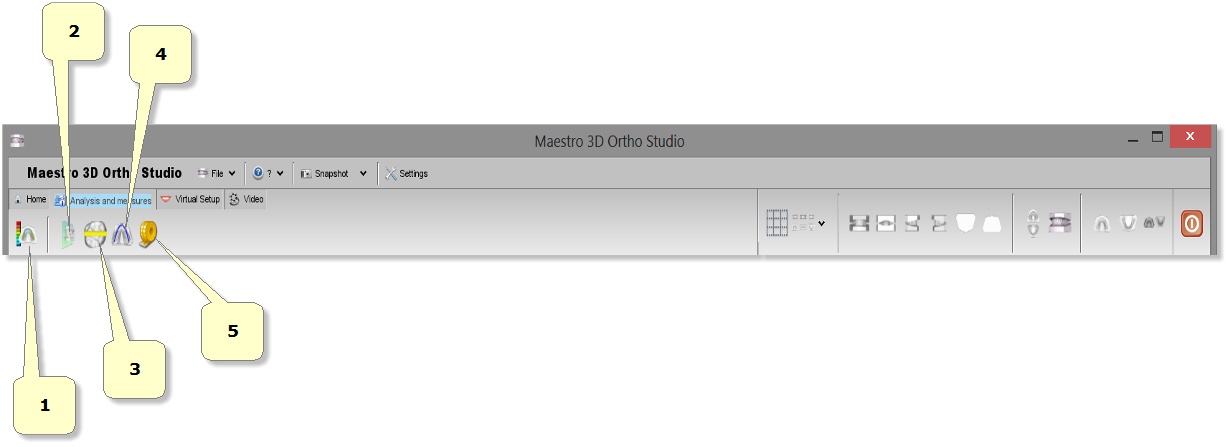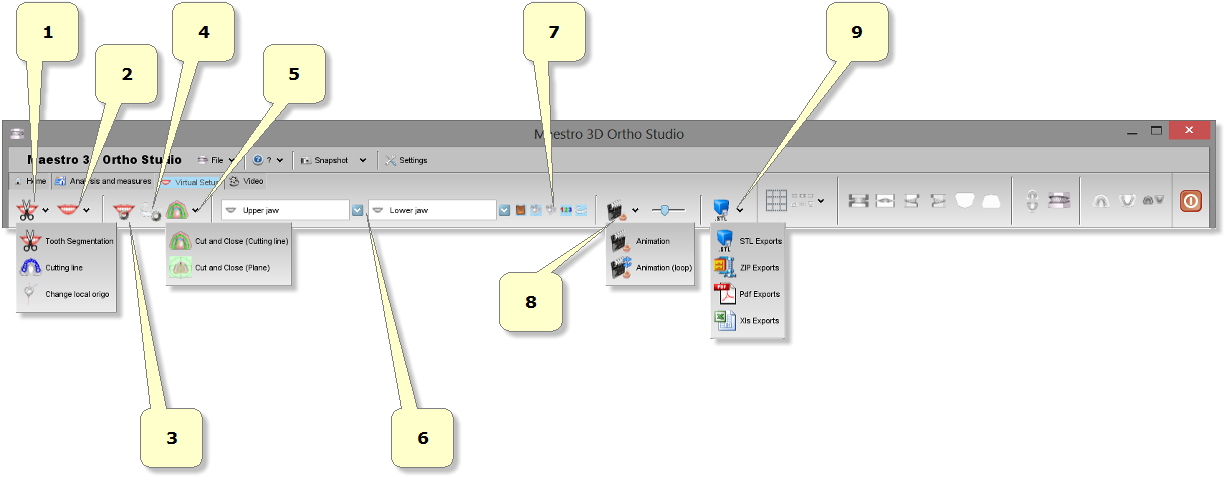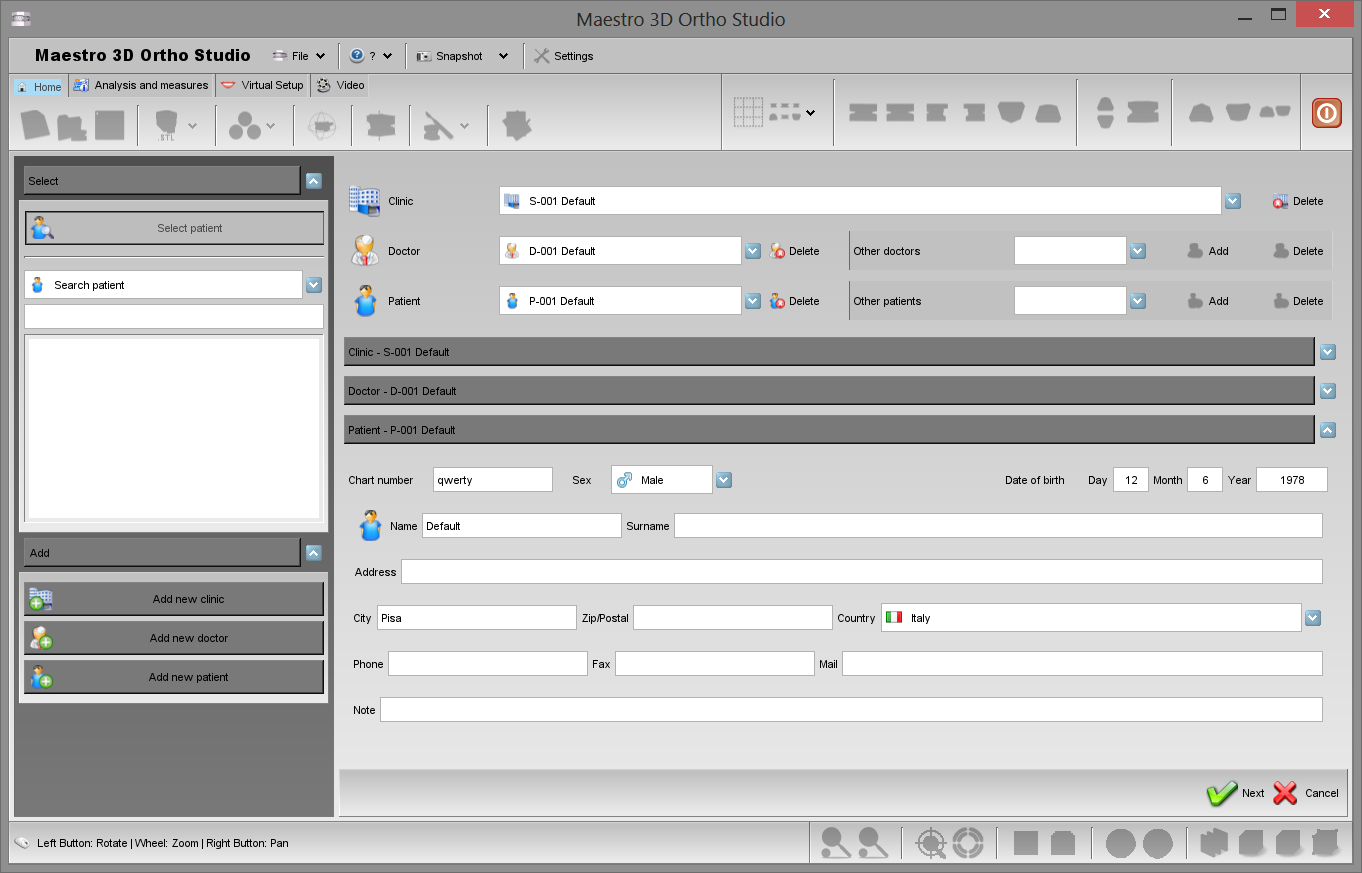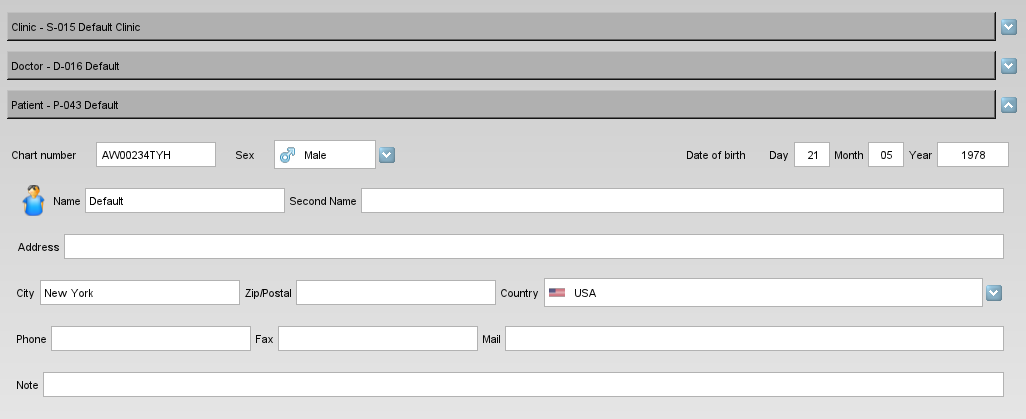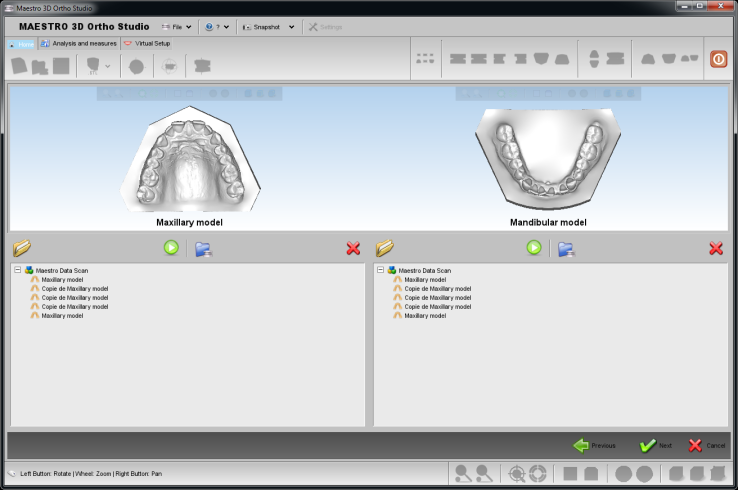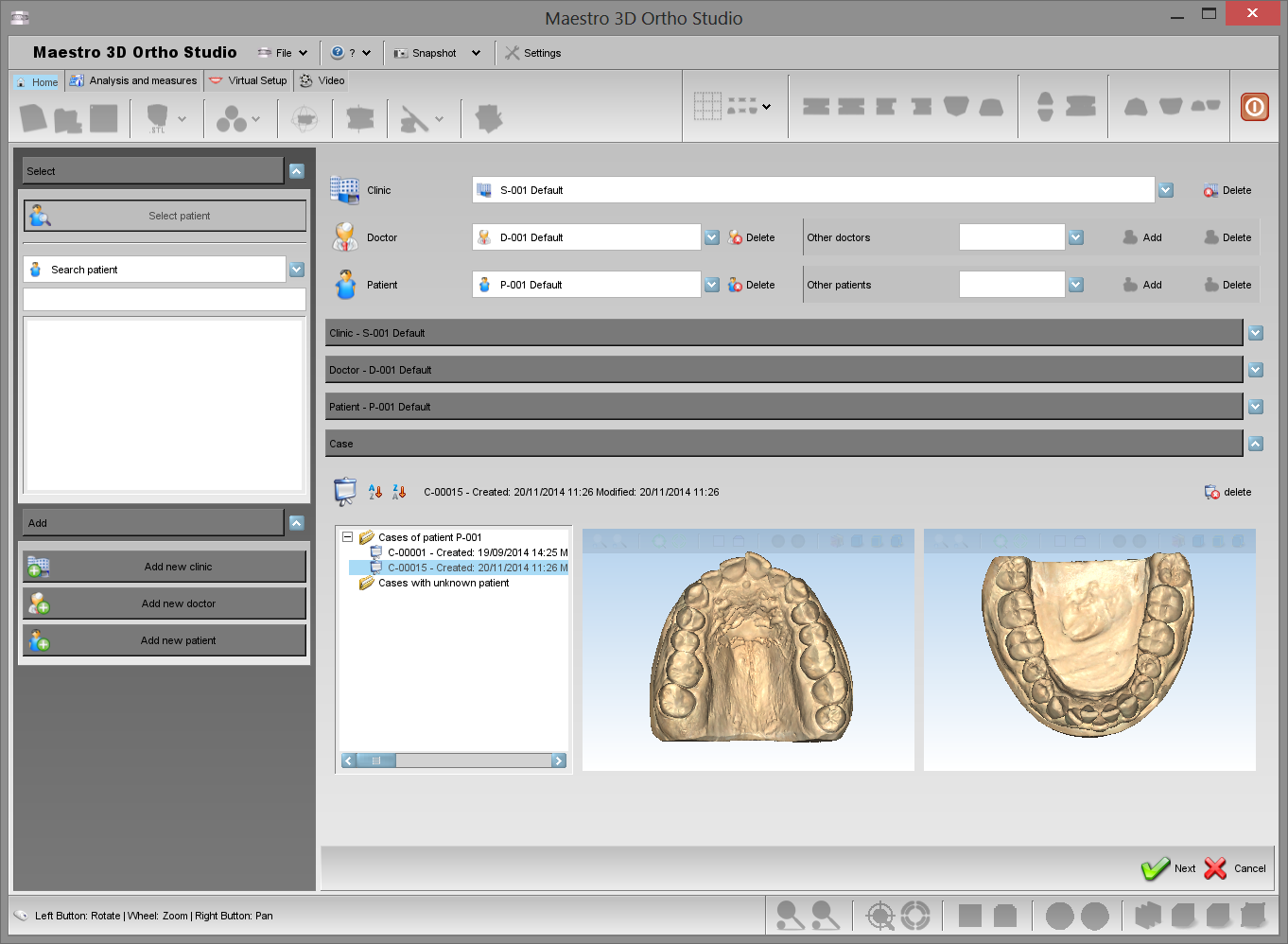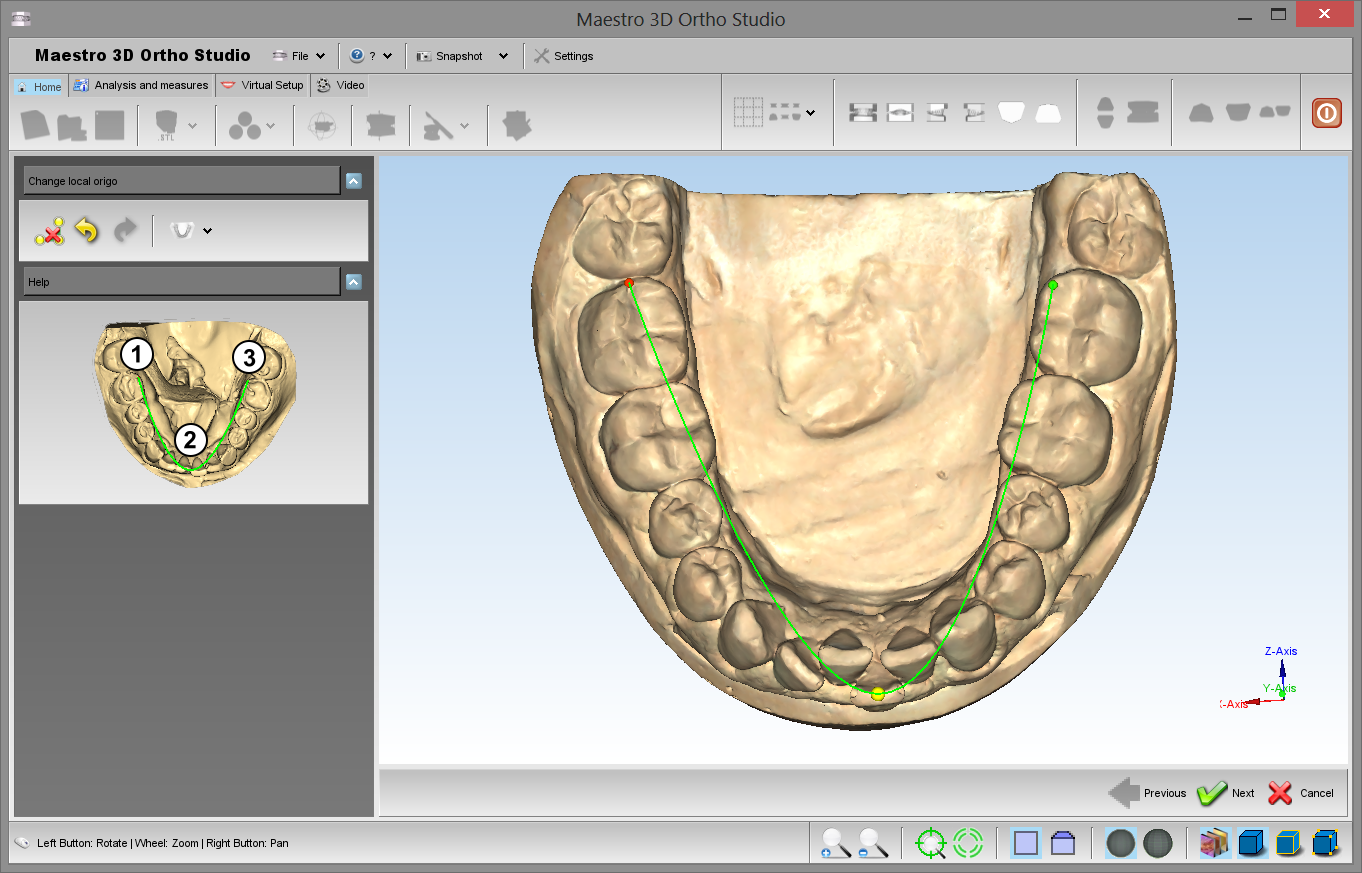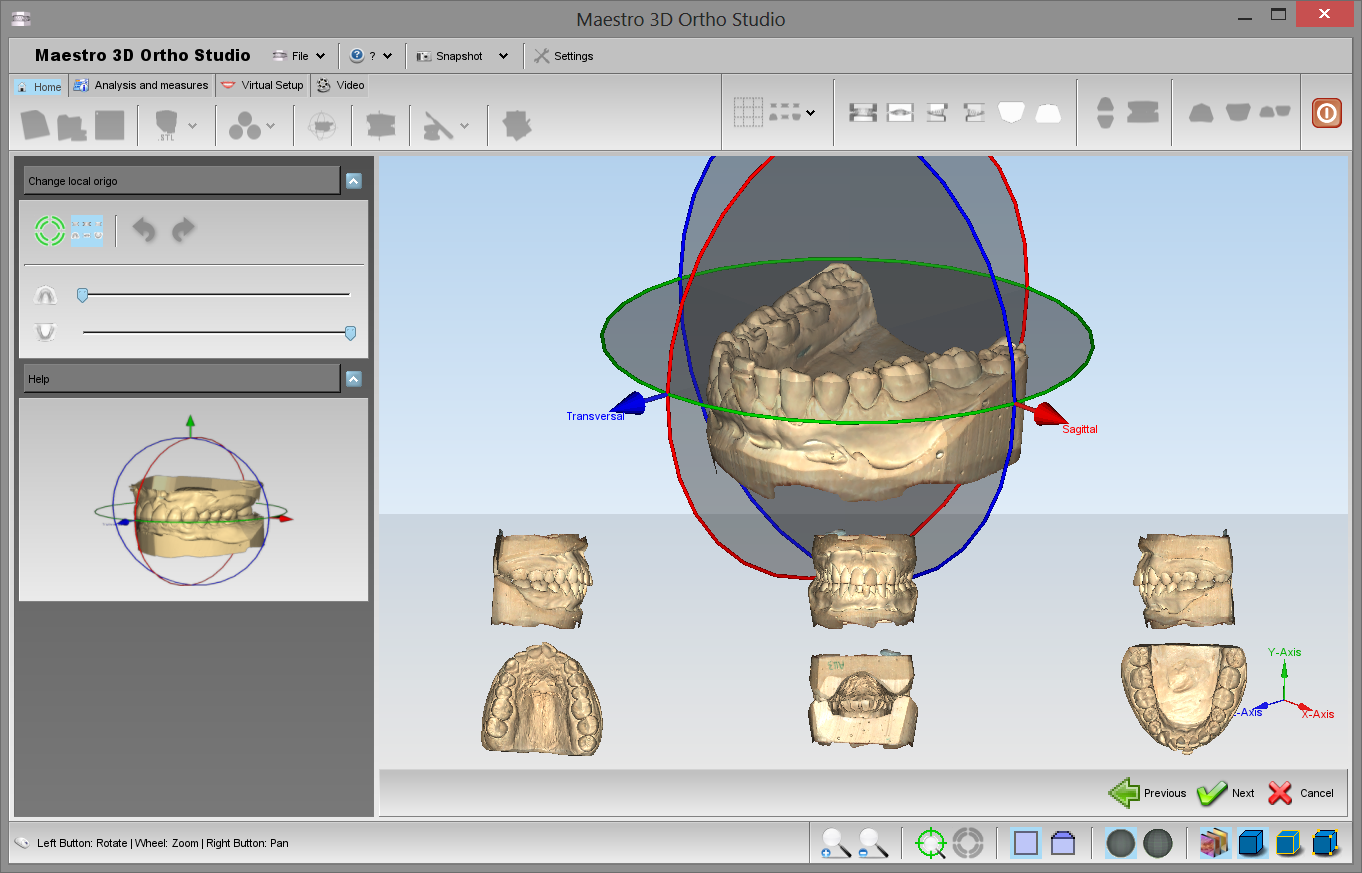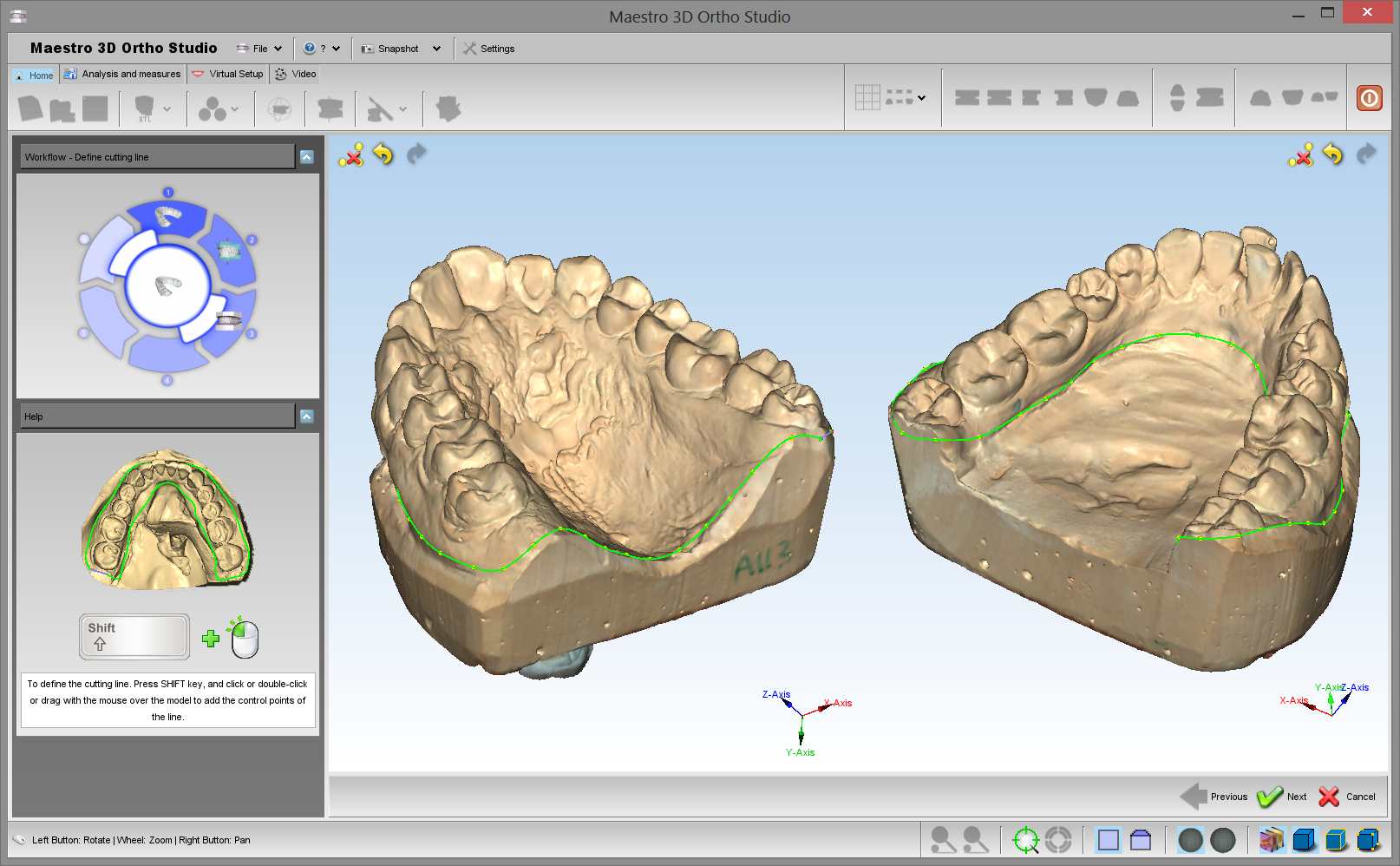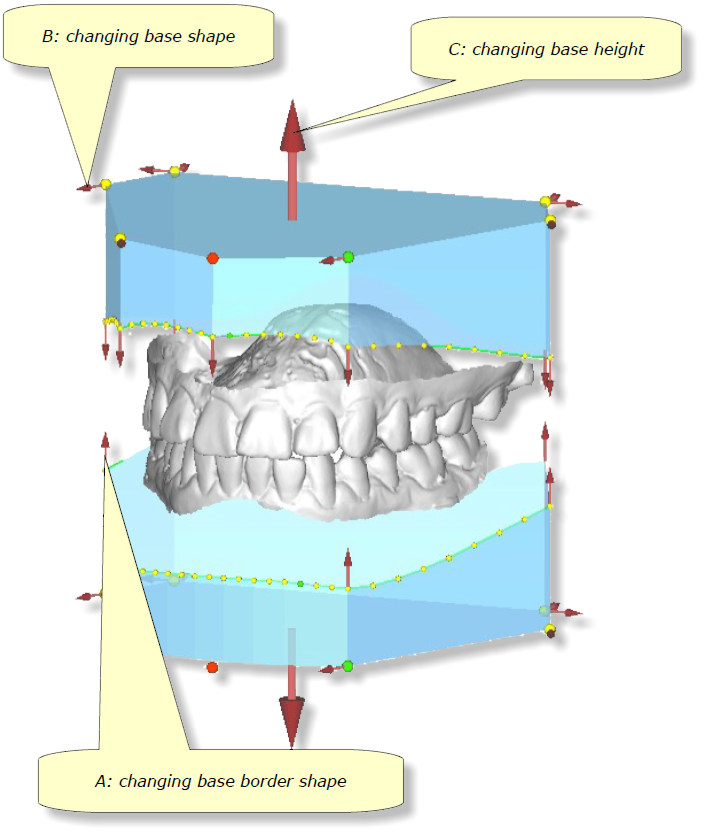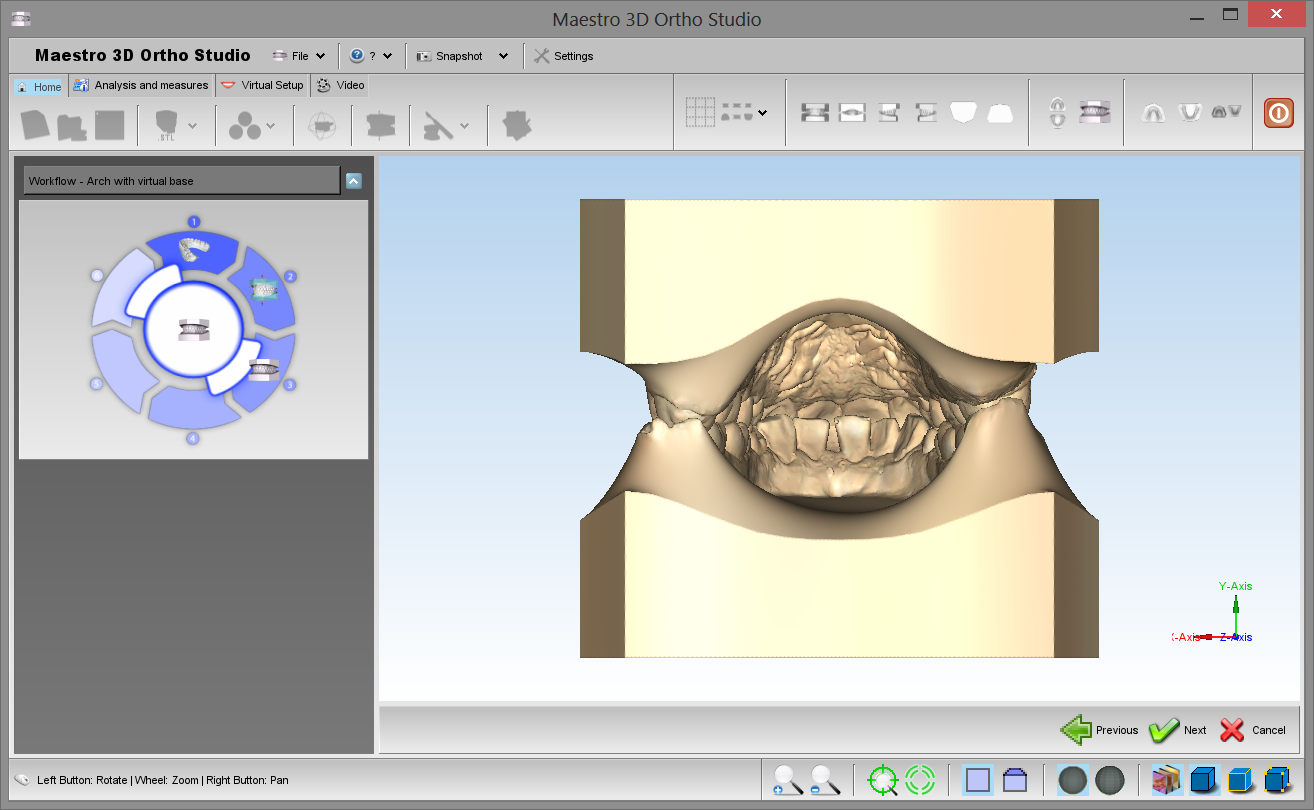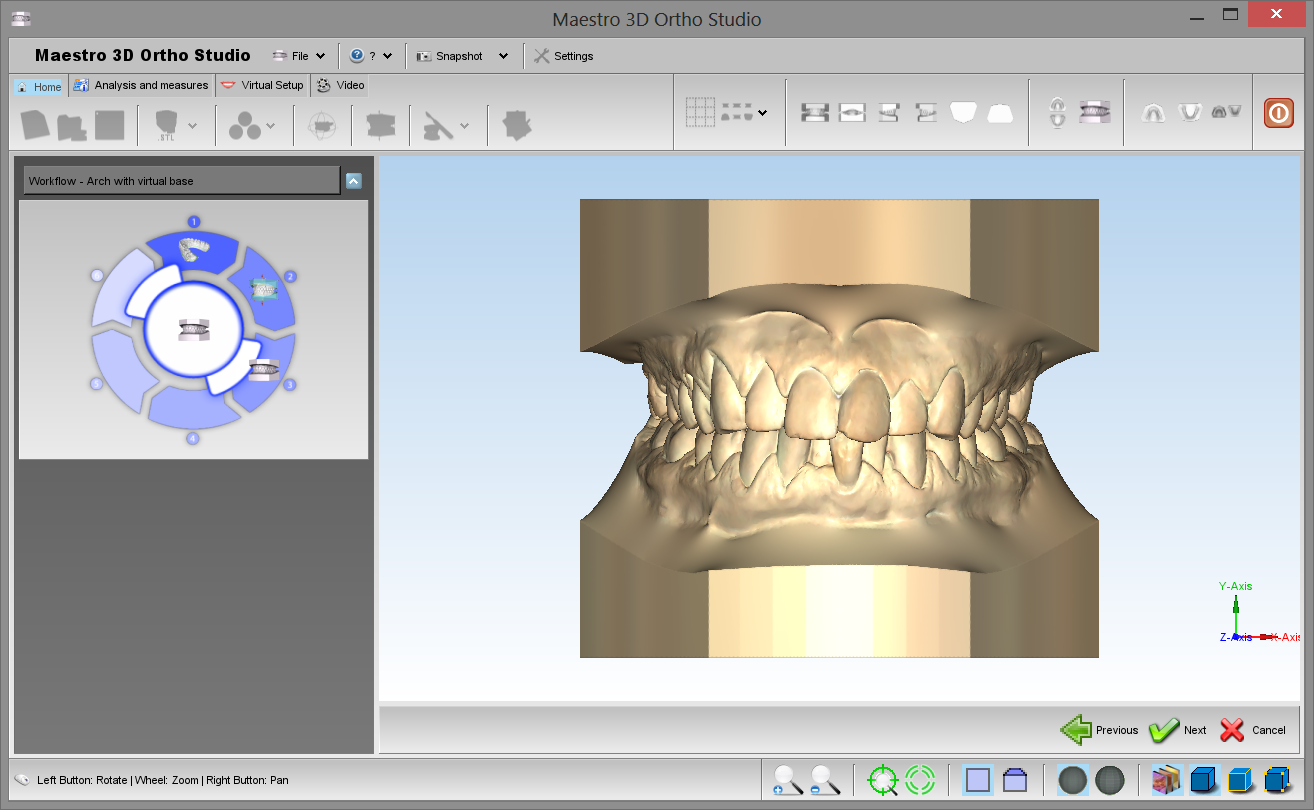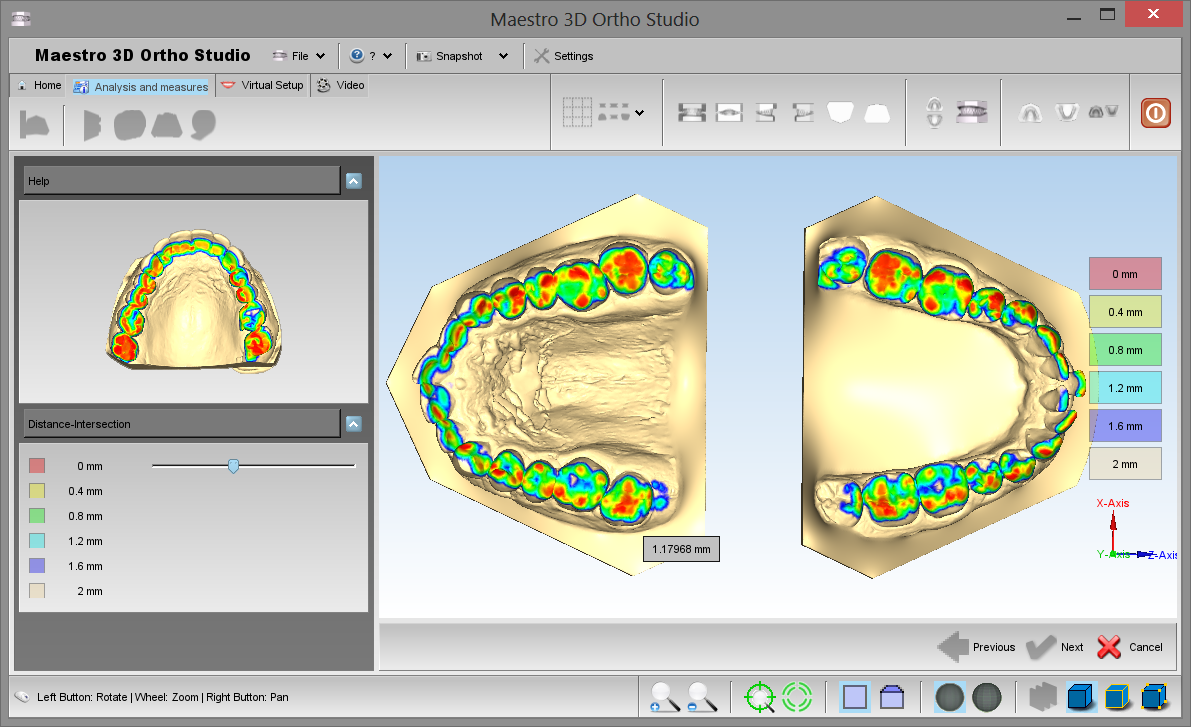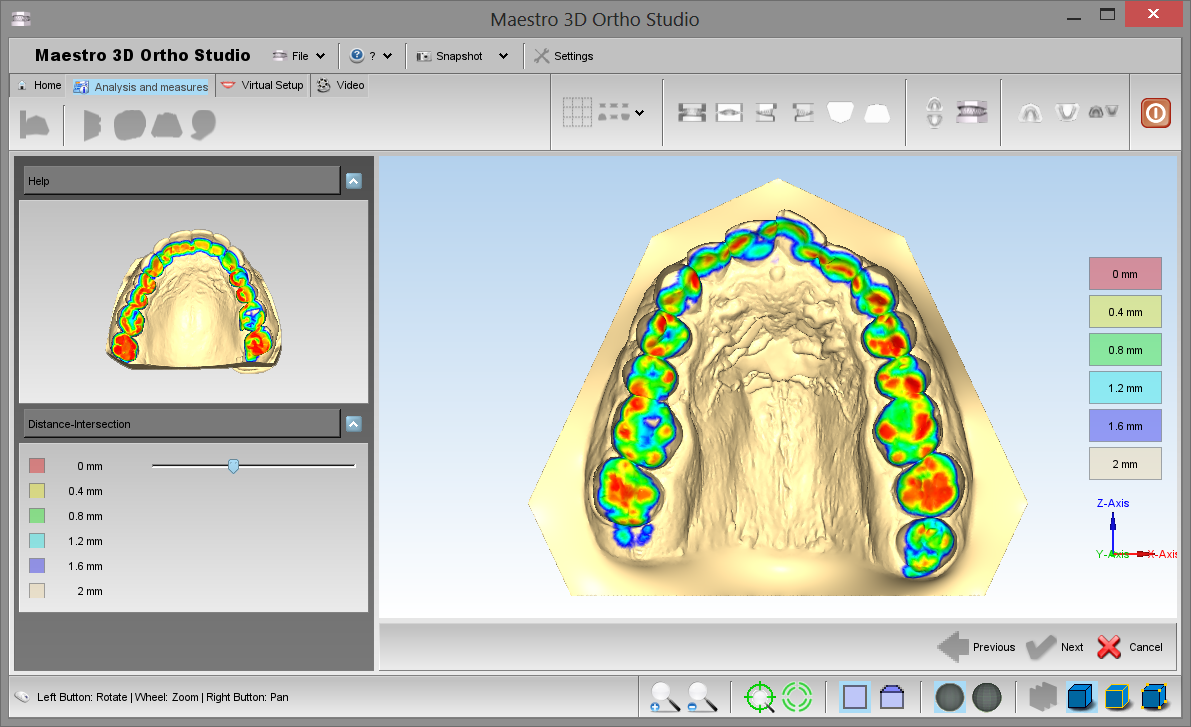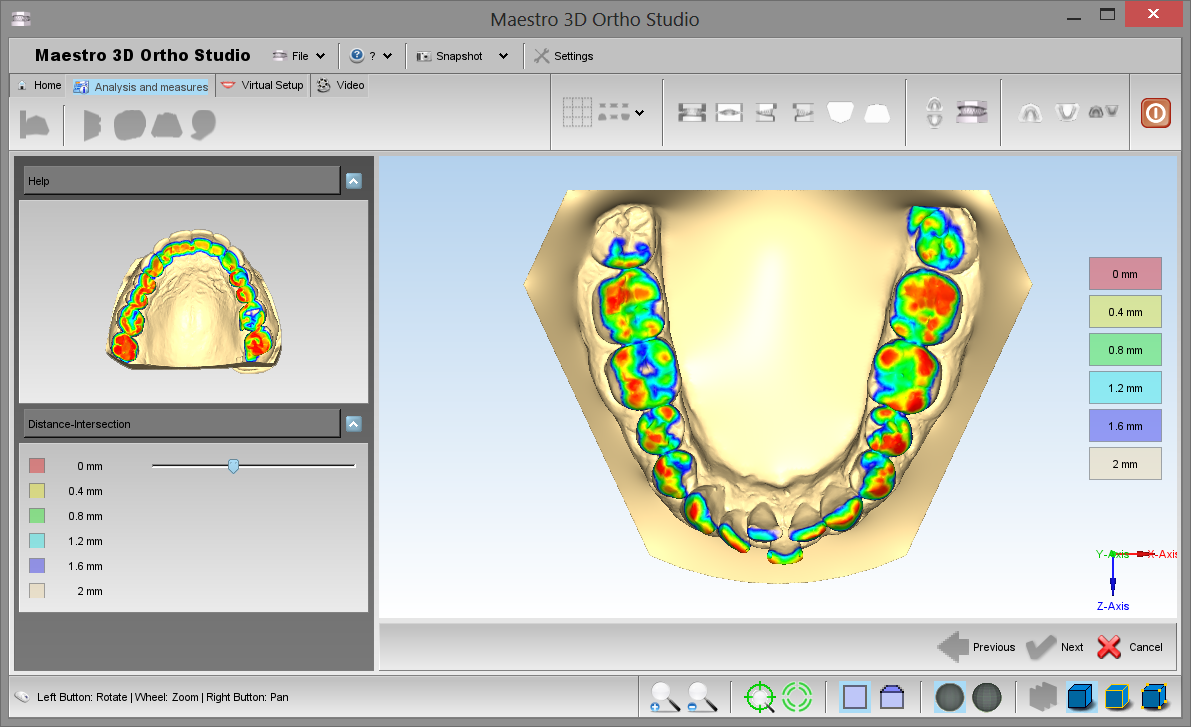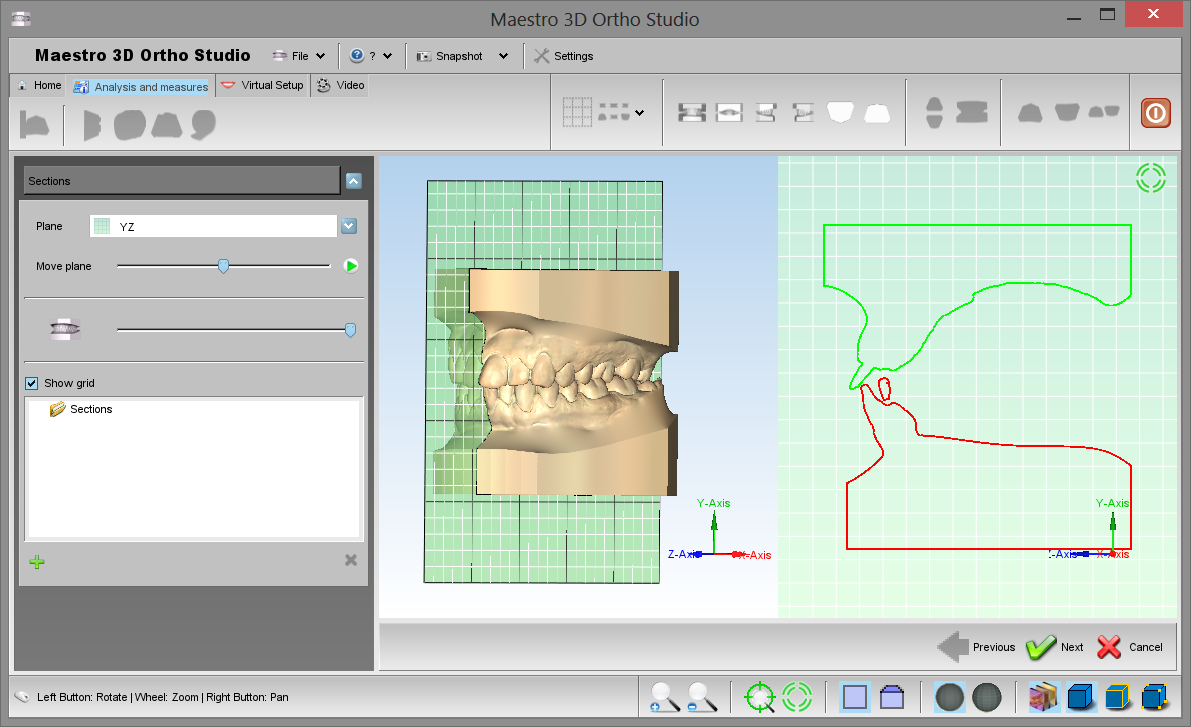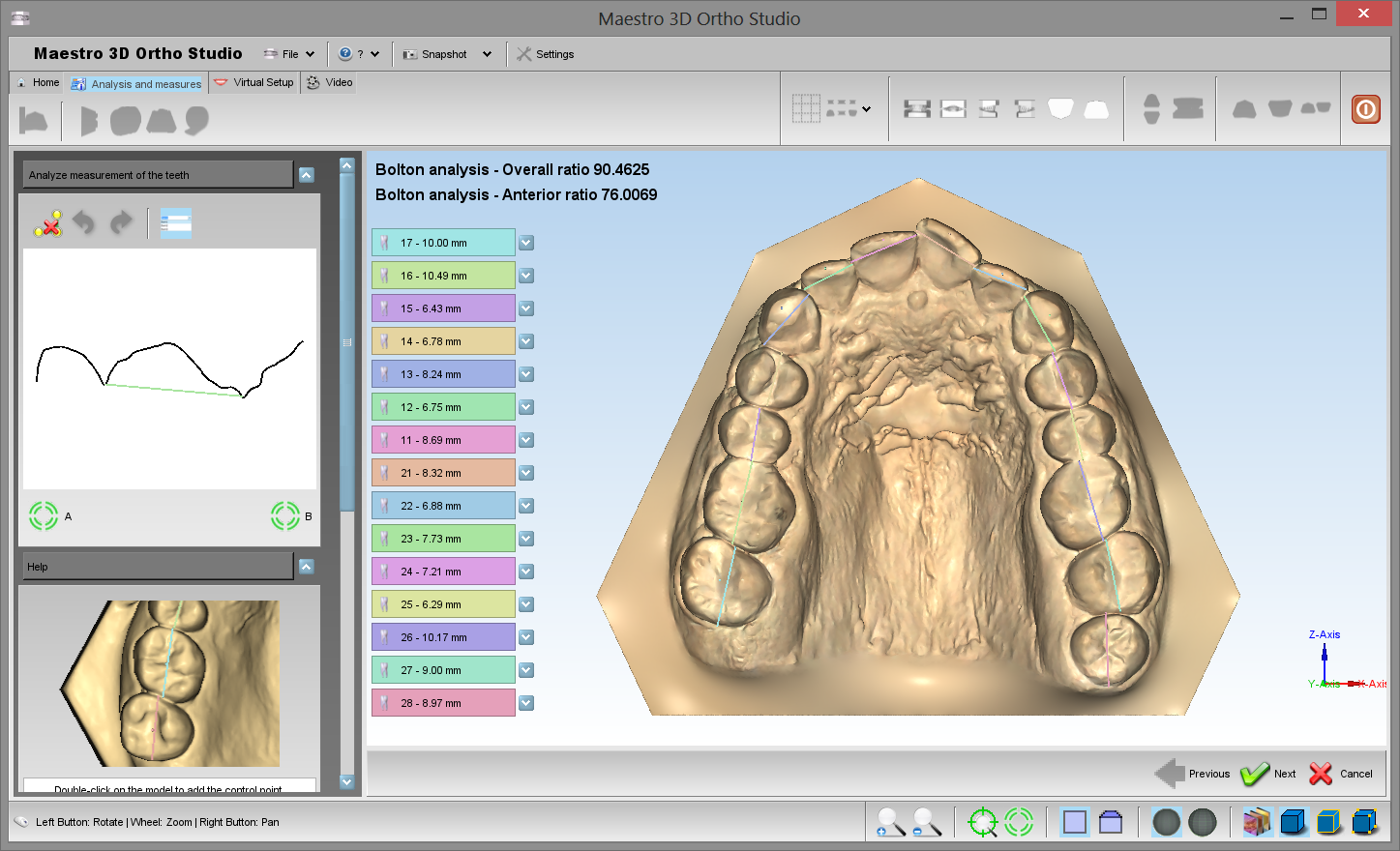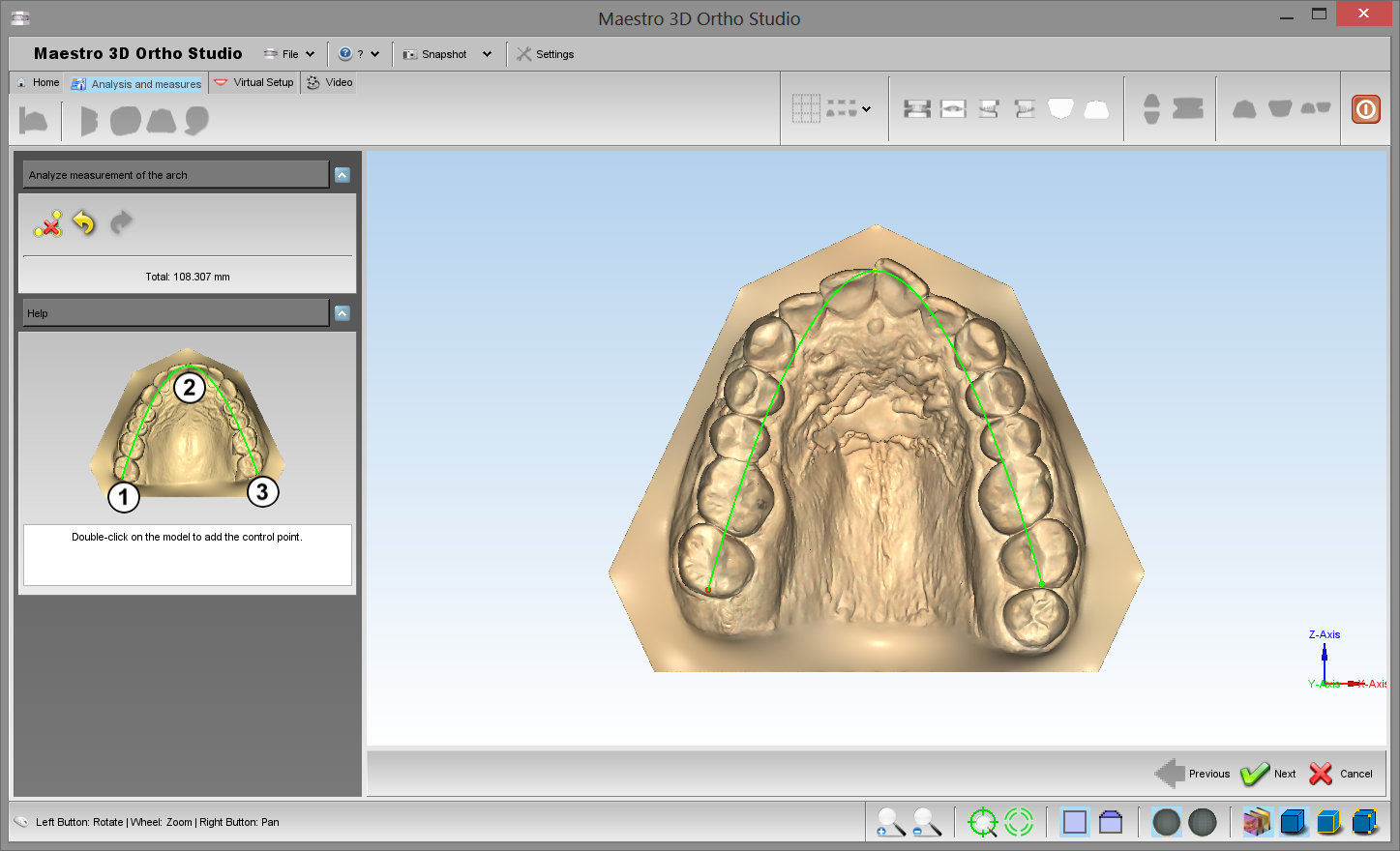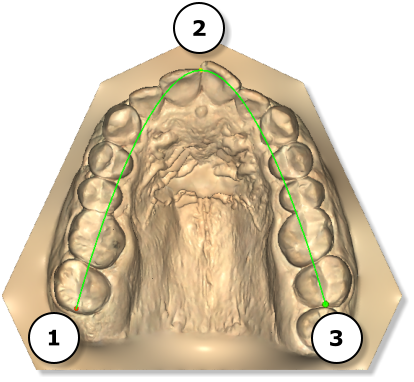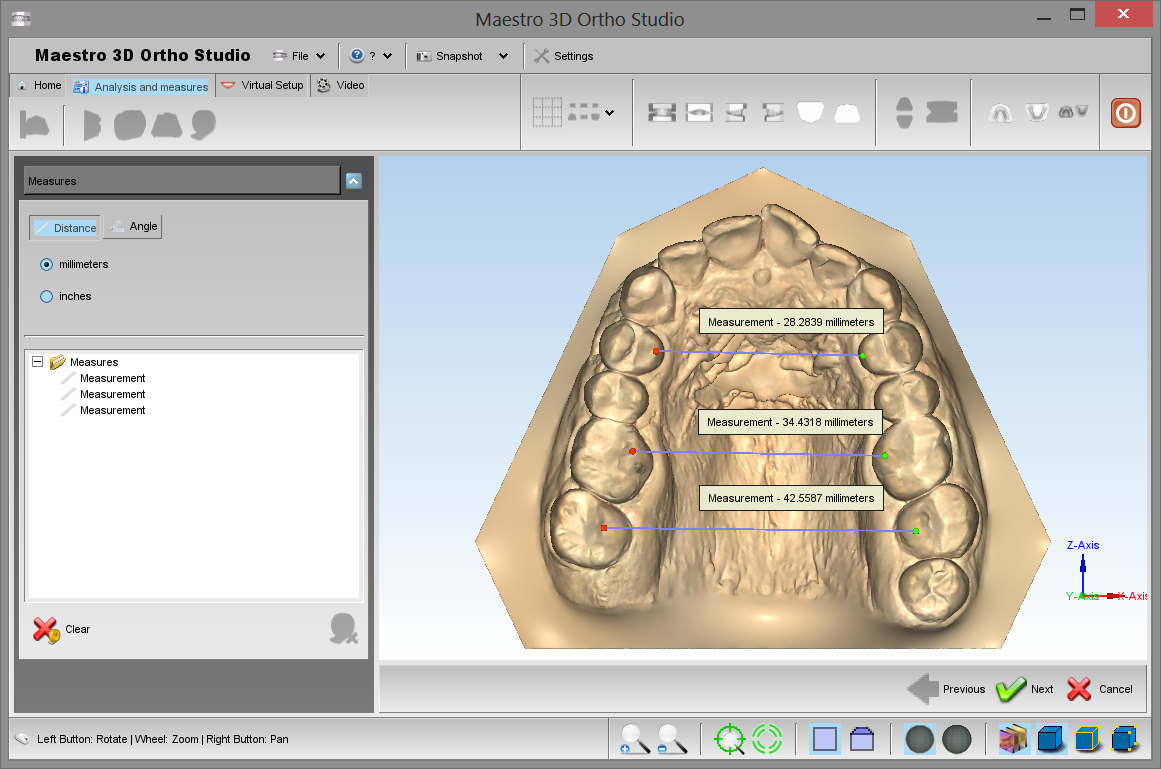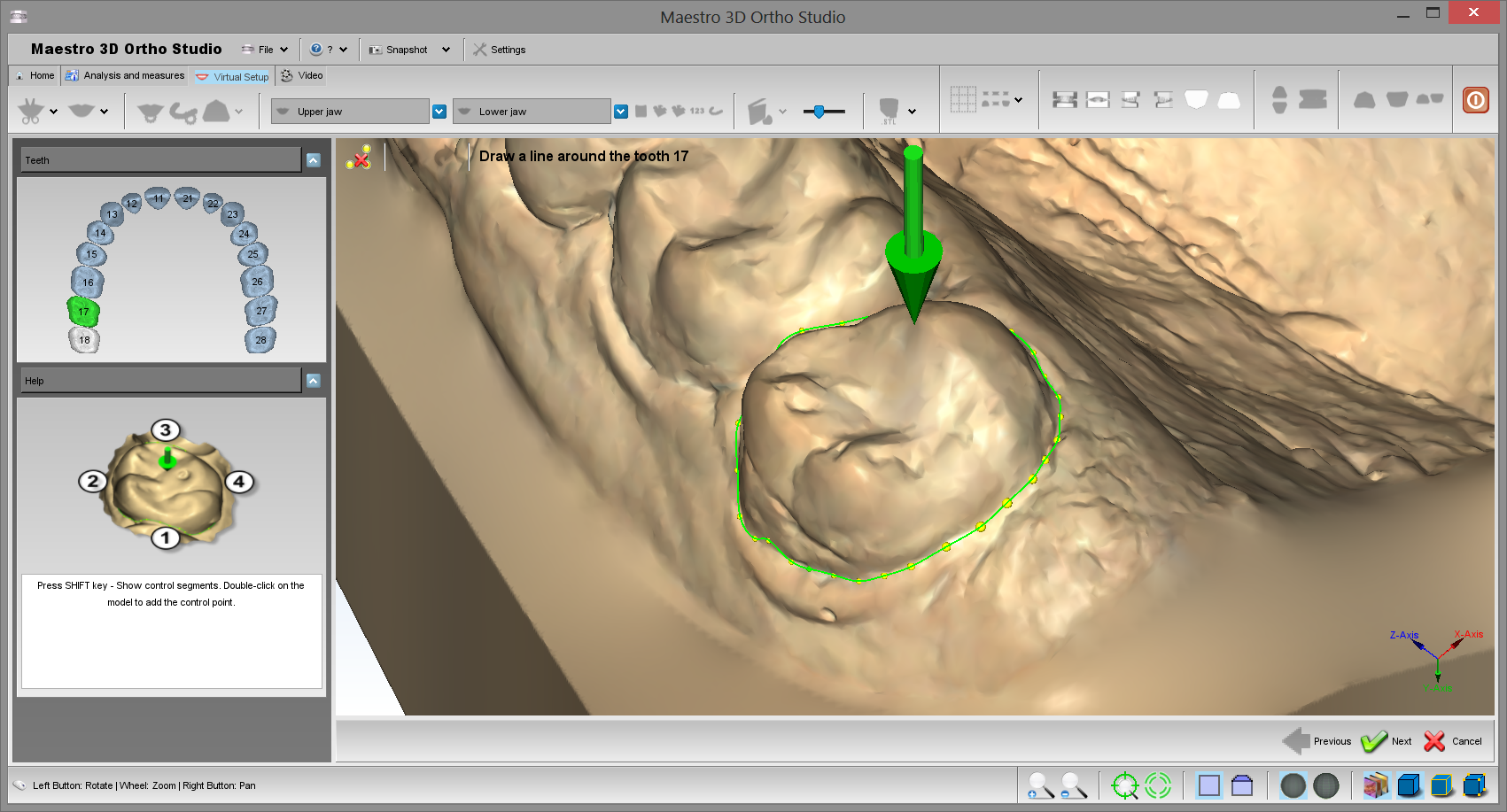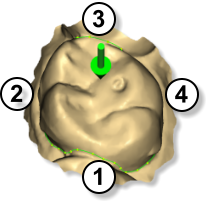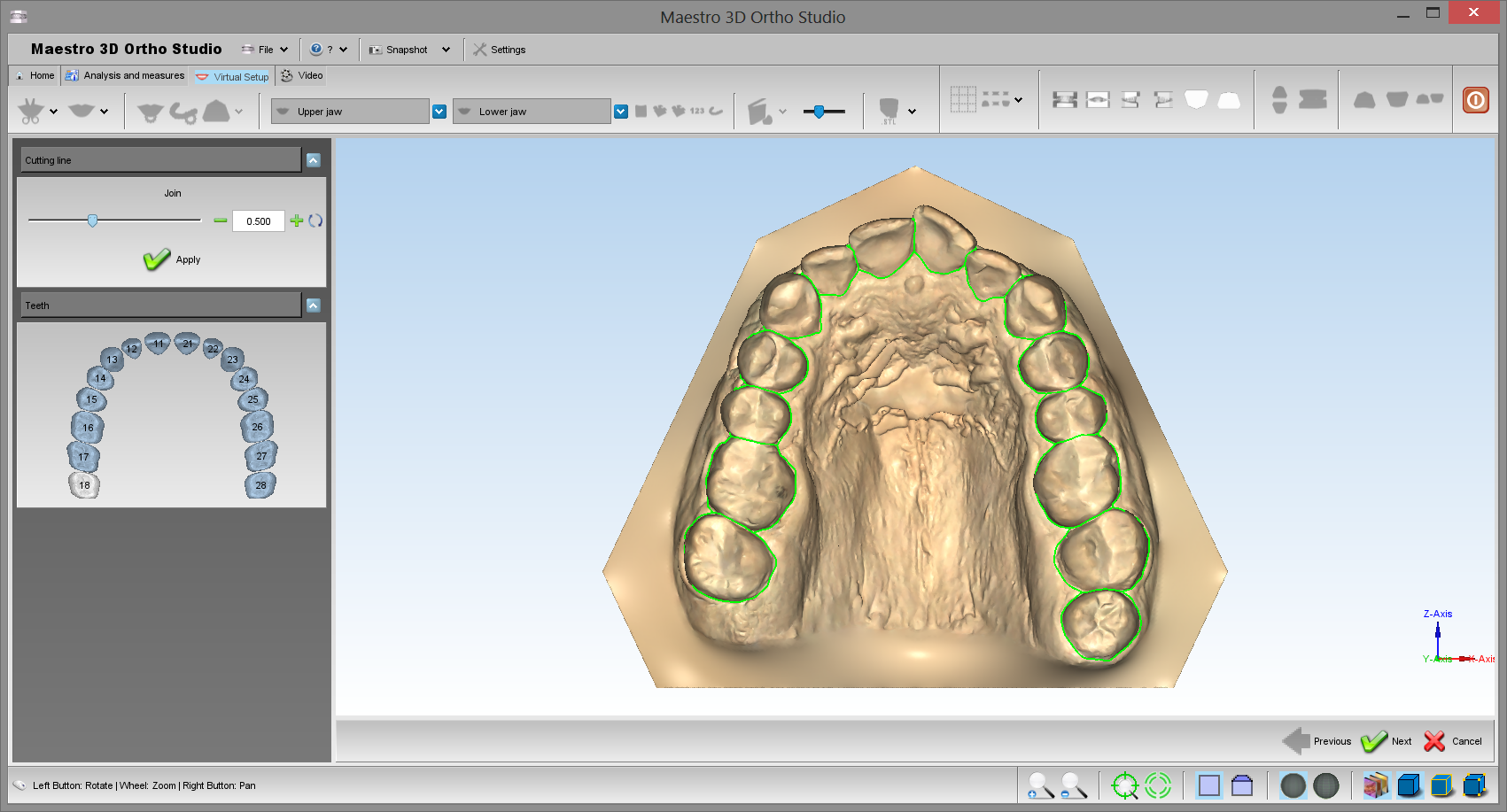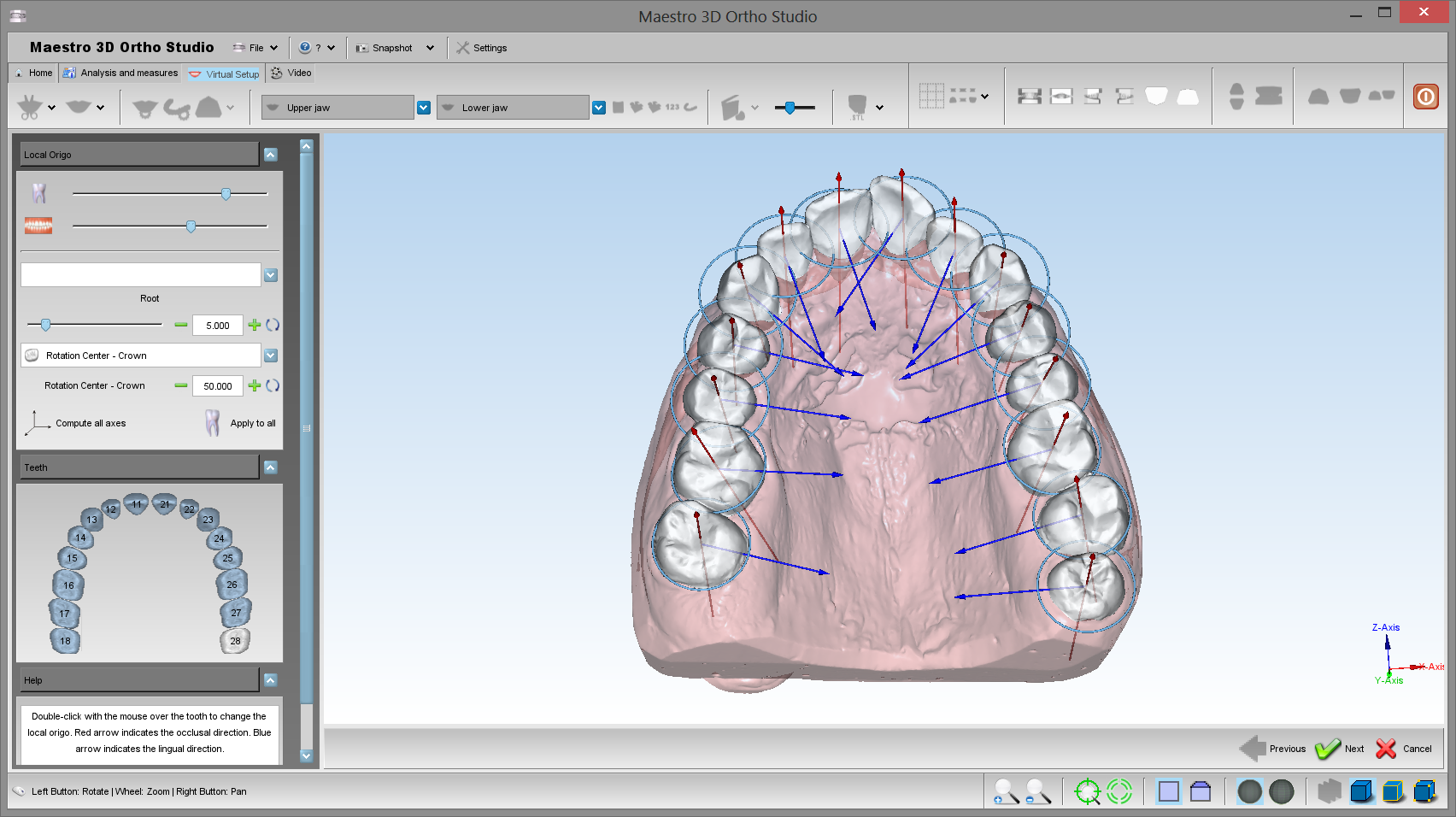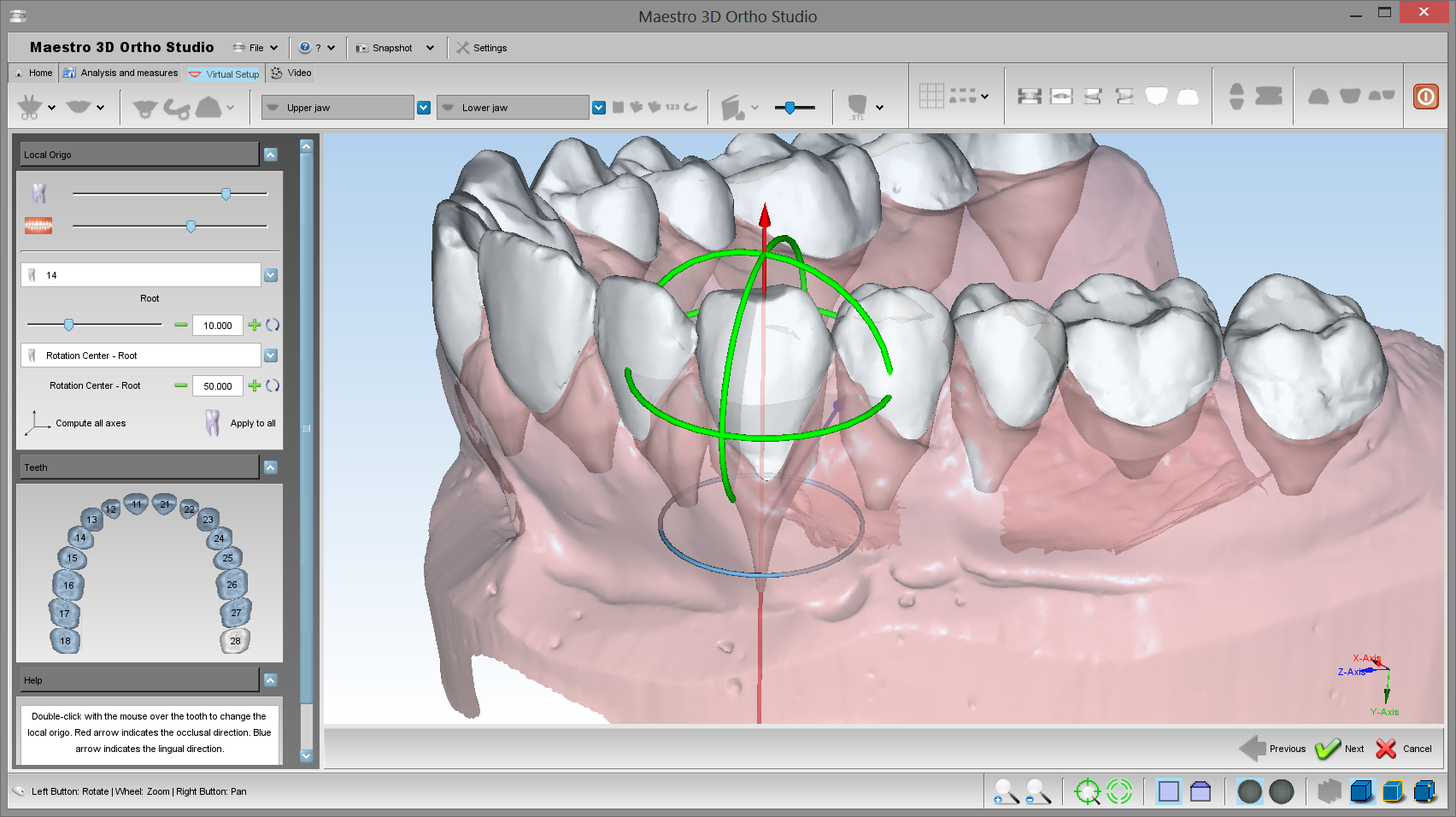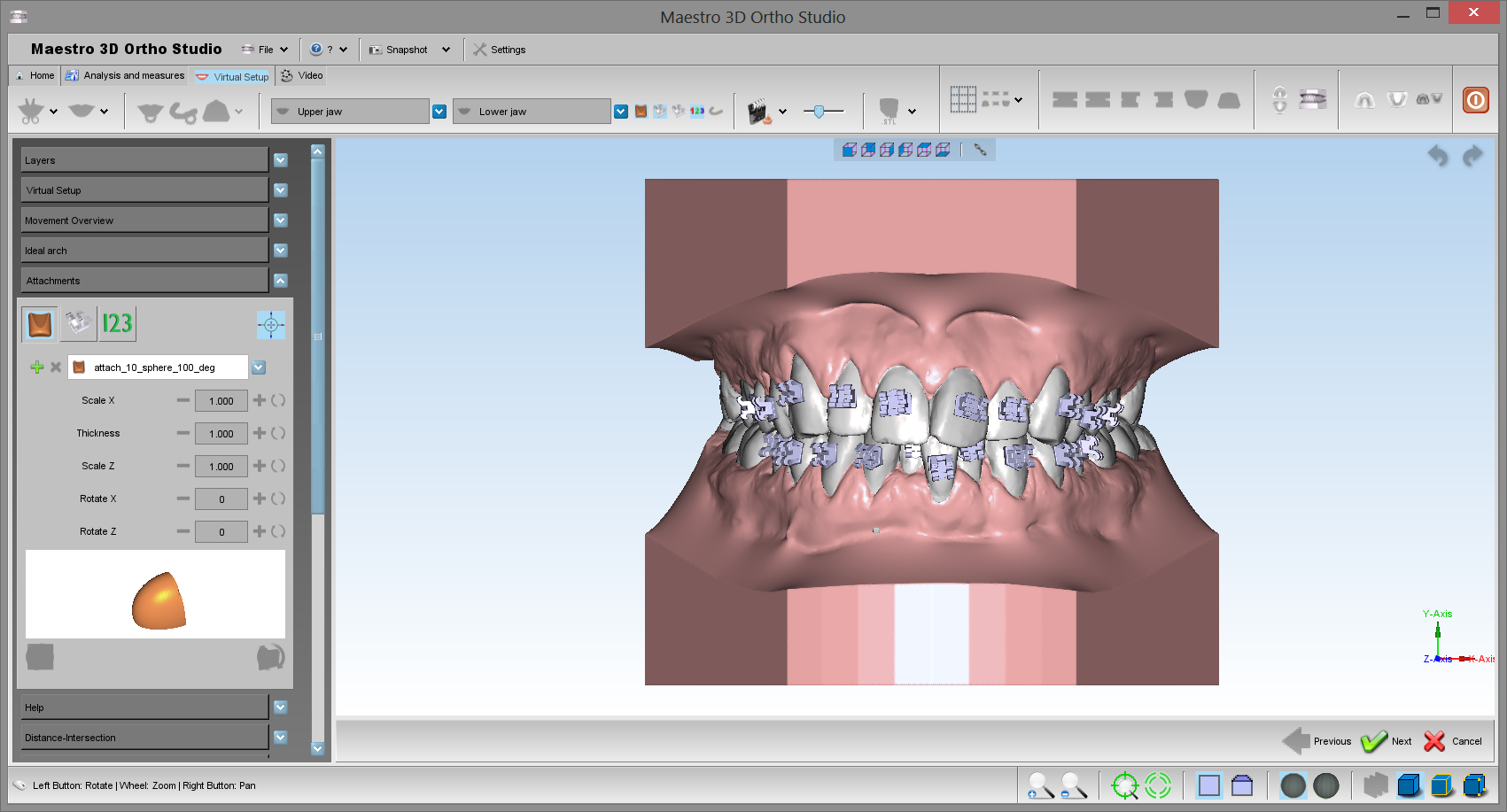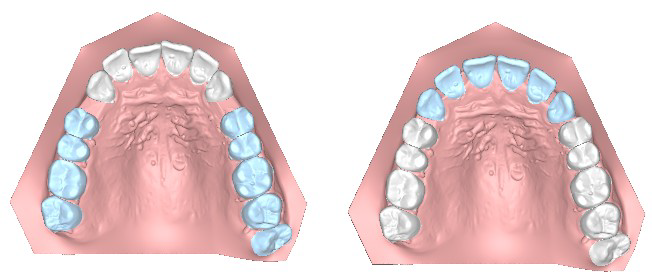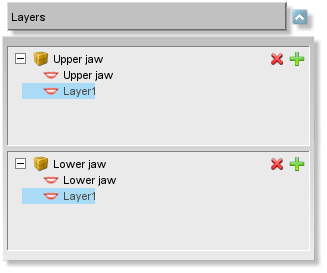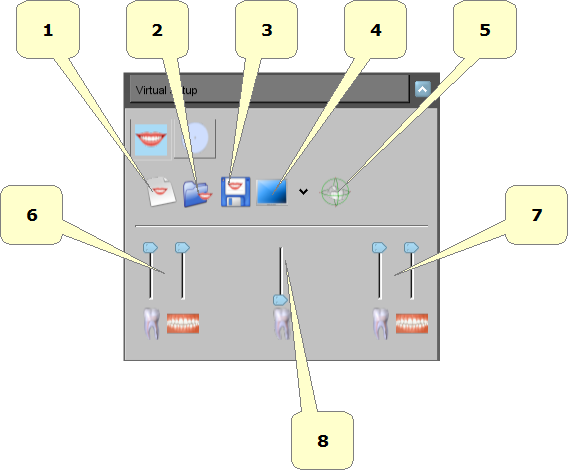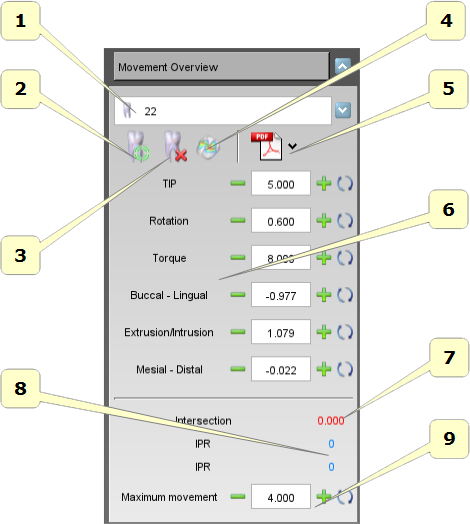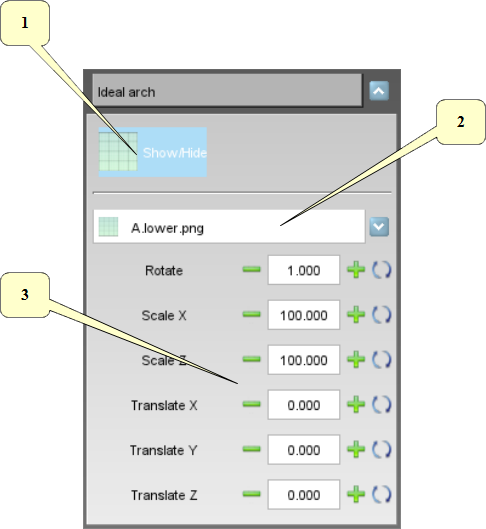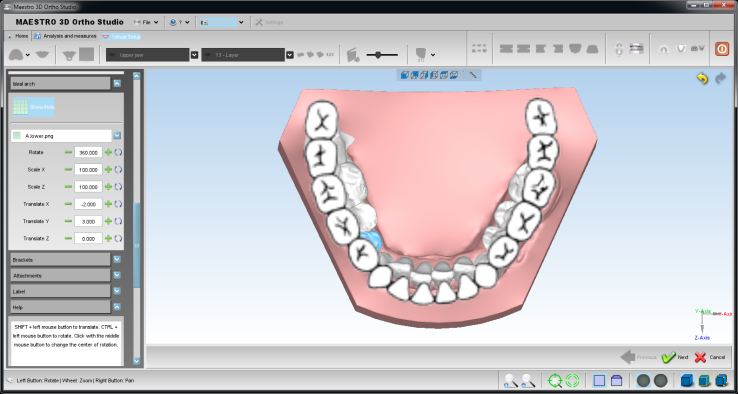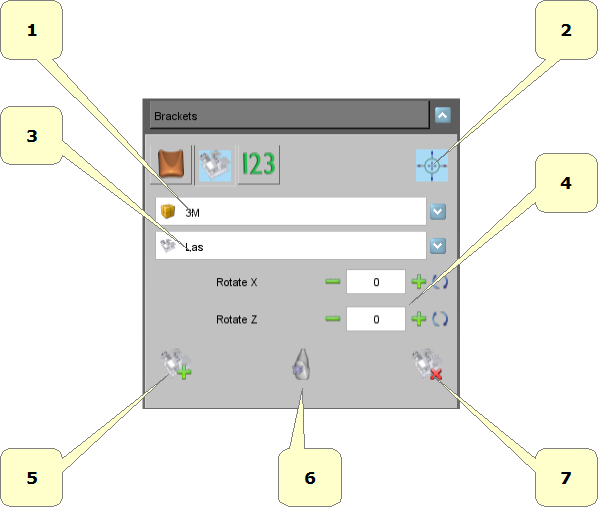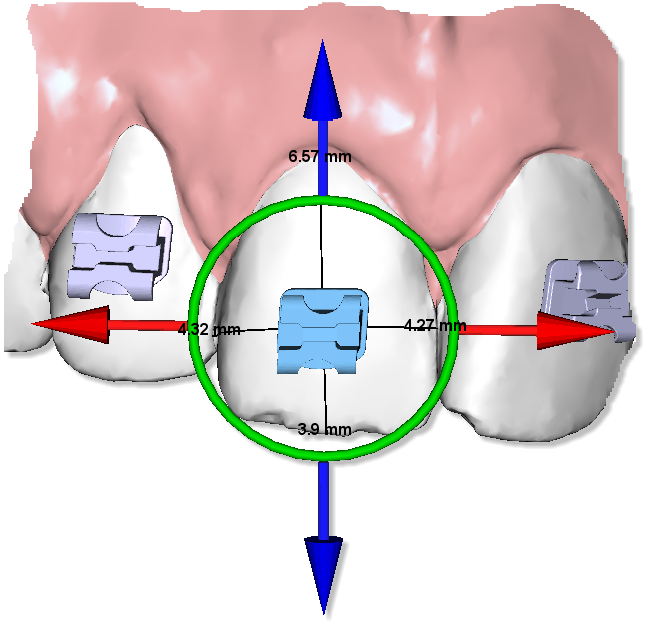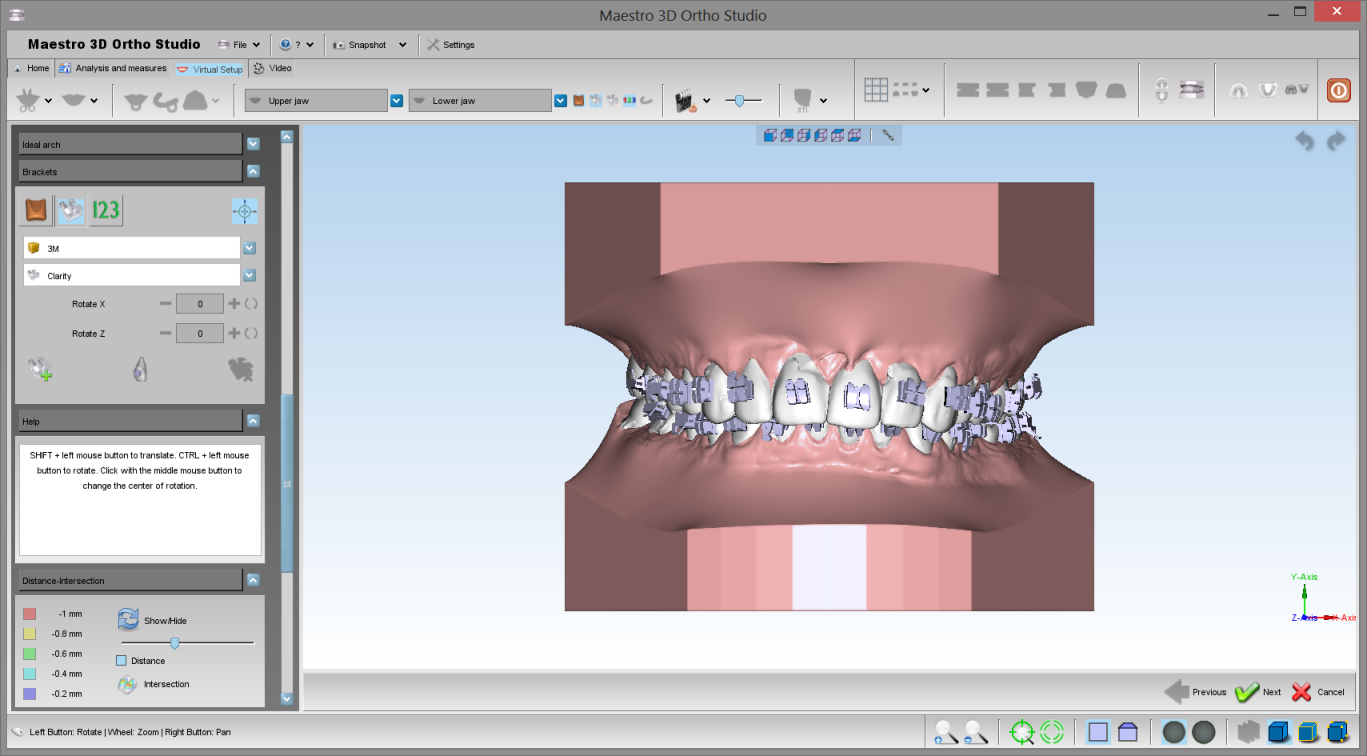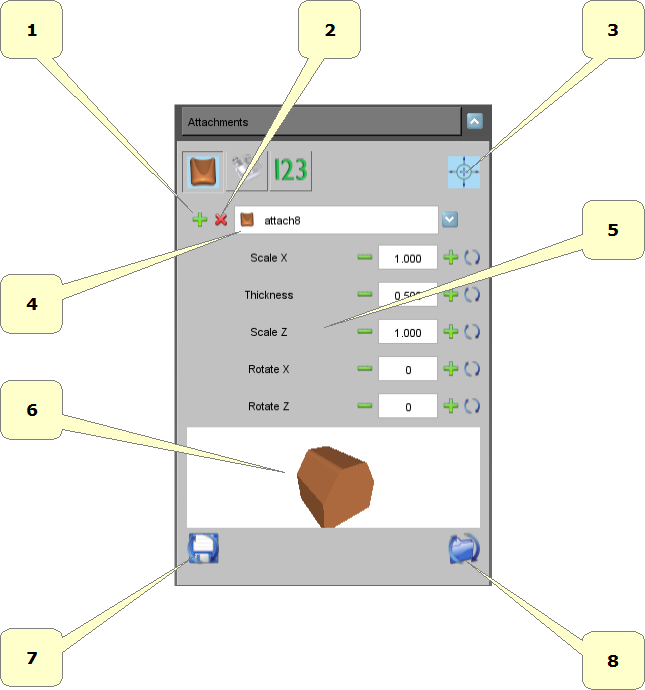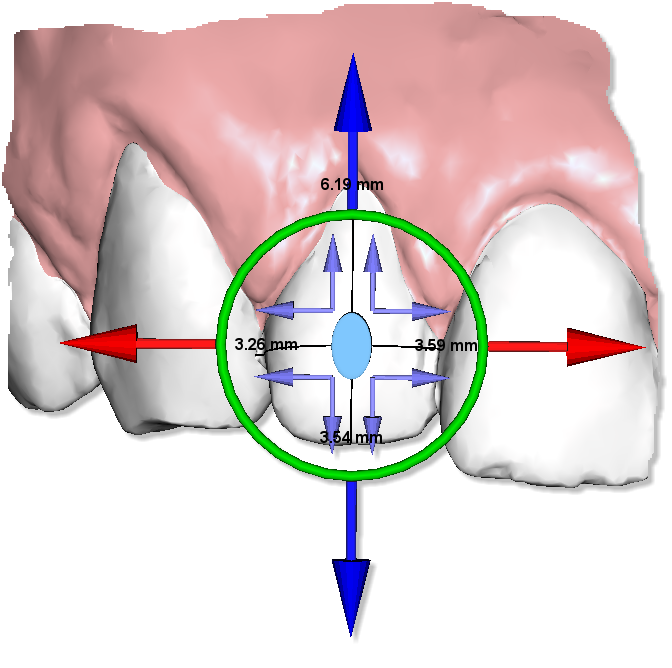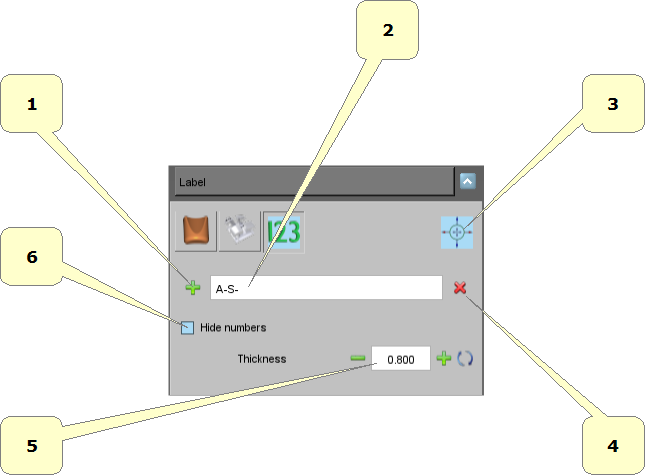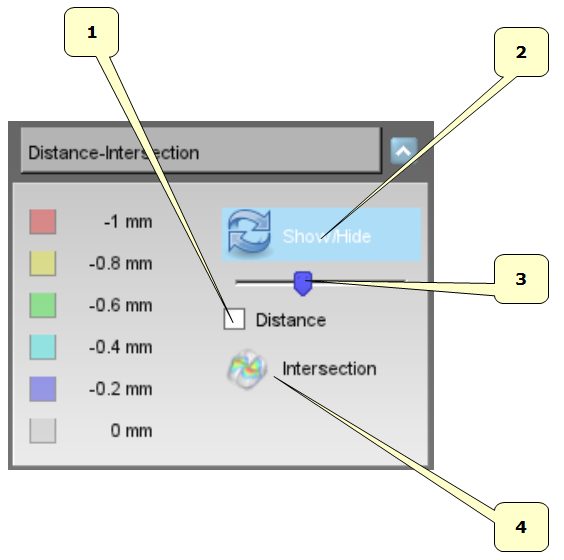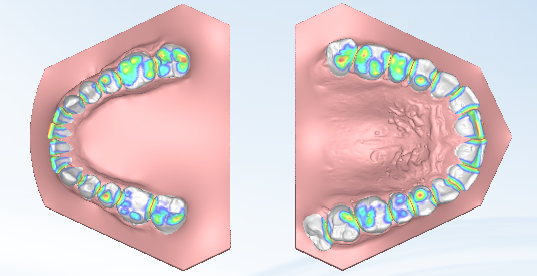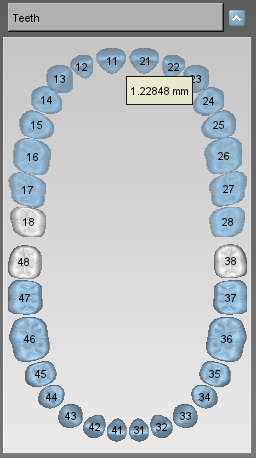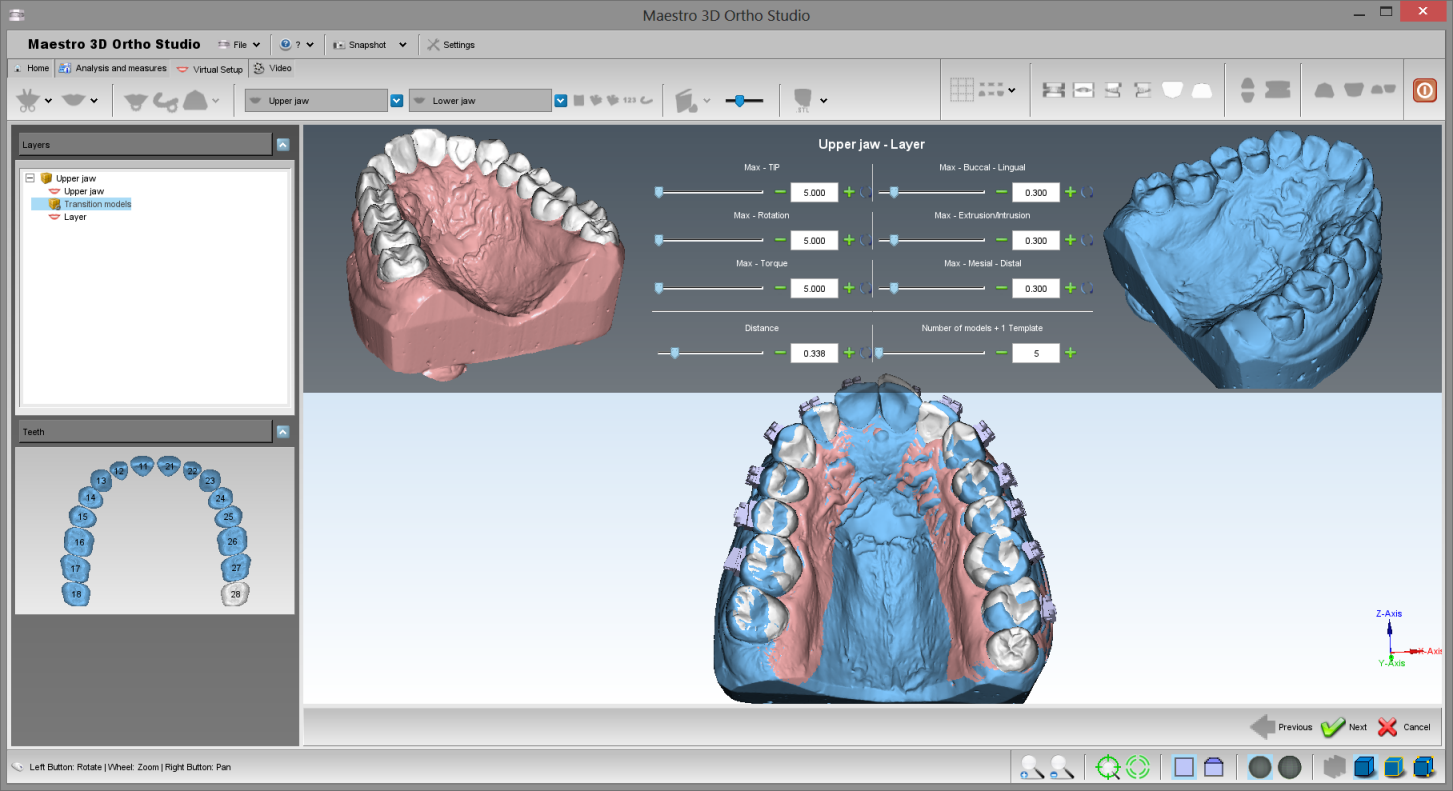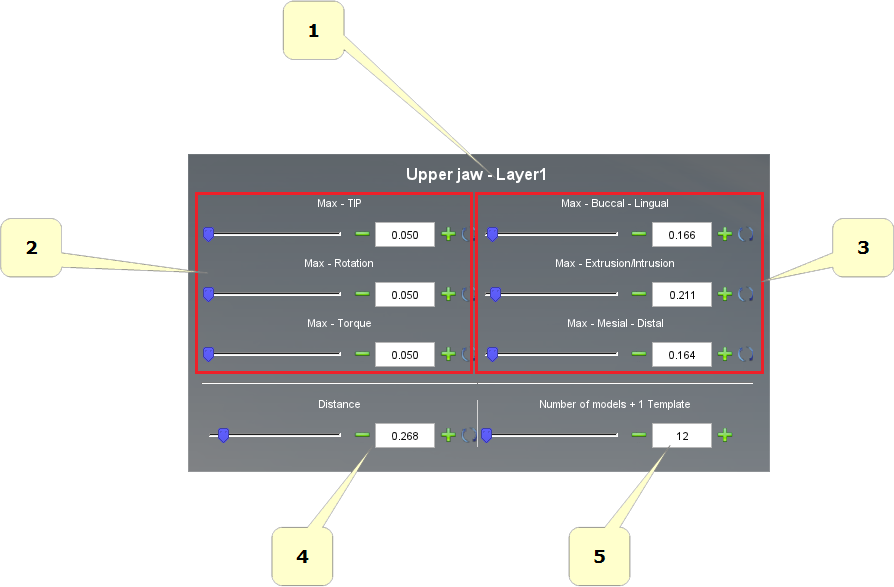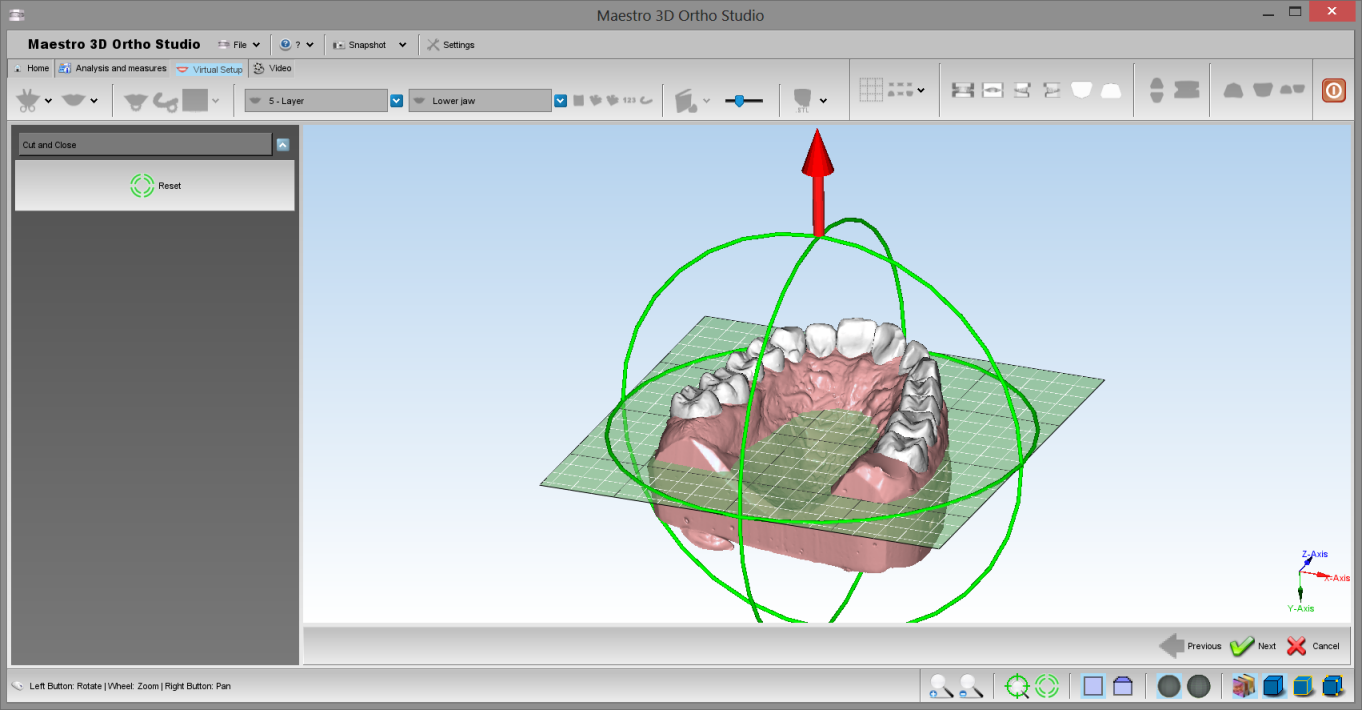Maestro 3D Ortho Studio - Manuale Utente
Introduzione all'utilizzo del software Maestro 3D Ortho Studio
Questo documento ha lo scopo di introdurre l'utente in modo semplice ed intuitivo all'uso del software Ortho Studio. Si prega di leggere attentamente il manuale prima di utilizzare il software.
Introduzione
Maestro 3D Ortho Studio è un software facile da utilizzare sia per i laboratori che per gli ortodonzisti.
Le principali caratteristiche sono:
- Gestione di una base di dati con Pazienti, Dottori e Cliniche.
- Scelta del sistema di riferimento per le due arcate.
- Creazione e modifica delle basi virtuali.
- Setup Virtuale.
- Ispezione occlusale.
- Analisi di distanze, misure e sezioni.
Installazione del Software
Per installare il software Maestro 3D Ortho Studio, fare doppio click sul file Maestro.3D.Ortho.Studio.vx.xx.xxx.Setup.exe
Step 1: Selezionare la lingua di installazione.
Step 2: Una finestra di benvenuto apparirà sullo schermo, premere Avanti per continuare.
Step 3: Si prega di leggere attentamente la licenza d'uso del software. Accettare la licenze e premere Avanti per continuare.
Step 4: Selezionare la cartella di destinazione. (Noi consigliamo di utilizzare la cartella di default). Premere Avanti per continuare.
Step 5: Selezionare la cartella del menu Start. (Noi consigliamo di utilizzare la cartella di default). Premere Avanti per continuare.
Step 6: Selezionare se desiderato di creare l'icona del programma sul Desktop. Premere Avanti per continuare.
Step 7: A questo punto apparirà sullo schermo il riassunto di tutte le opzioni di installazione selezionate. Premere Installa per installare il software.
Una barra di progresso mostrerà l'avanzamento dell'installazione.
Step 8: Installazione completata. Premere Finire per completare.
| Utilizzare Windows 7 - 64 bit.
Installare tutti gli update di Windows disponibili. Installare gli ultimi driver disponibili dal sito di NVIDIA, web site http://www.nvidia.com. Impostare lo slider UAC (controllo account utente) al minimo. Tasto destro del mouse sopra l'icona del software e Proprietà -> Avanzate -> (spuntare) Esegui come Amministratore. |
Interfaccia Utente
La figura sotto mostra come appare l'interfaccia utente del software.
Toolbar Principale
La toolbar principale permette di accedere a tutte le funzionalità dell'Ortho Studio Software.
- 1) nuovo caso.
- 2) apri un caso esistente.
- 3) salva caso corrente.
- 4) esporta:
- come Ortho: esporta il caso corrente in *.ortho file format. Utile per fare del digital service per i propri clienti. Con Ortho Studio Viewer i clienti possono vedere, ispezionare e misure i modelli ed anche il setup virtuale.
- come Orthoipad: esporta il caso corrente in *.orthoipad file format. Utile per fare del digital service per i propri clienti che hanno un Apple iPad. Con Ortho Studio Viewer iPad i clienti possono vedere ed ispezionare i modlli. Questa funzione di esportazione è accessibile solo se si utilizza uno scanner della linea Maestro insieme al software Ortho Studio. Scarica Ortho Studio Viewer per iPad qui: Ortho Studio Viewer iPad
- come Stl: esporta il caso corrente in una cartella. La cartella conterrà un file *.txt con le informazioni del caso e i modelli mascellari e mandibolari in *.Stl file format.
- 5) cambia sistema di riferimento.
- 6) cambia articolazione.
- 7) aggiungi basi virtuali.
- 8) Modellazione.
- 9) viste multiple.
- 10) viste:
- vista frontale.
- vista posteriore.
- vista lato destro.
- vista lato sinistro.
- vista superiore.
- vista inferiore.
- 11) apri/chiudi bocca.
- 12) visualizza mandibola/mascella/tutto. Cambiando la vista fra mascella o mandibola o entrambe si attivano\disattivano alcune funzionalità del software.
- 13) uscita.
- 1) ispezione occlusale. Calcola le distance e i punti di contatto fra la mascella e la mandibola.
- 2) sezioni.
- 3) misure dei denti.
- 4) lunghezza dell'arcata.
- 5) misure libere:
- misure punto-punto.
- misure di angoli.
- 1) segmentazione:
- segmentazione dei denti: disegna una linea di margine per ogni dente.
- linea di taglio: separa i denti dalla gengiva.
- cambia sistema di riferimenti: aggiusta il sistema di riferimento e la radice per ogni dente.
- 2) setup virtuale.
- 3) costruzione dei modelli.
- 4) taglia e chiudi.
- 5) menu a tendina dei modelli mascellari e mandibolari.
- 6) mostra/nascondi attachi/brackets/brackets key/etichette.
- 7) animazione.
- 8) esporta:
- come file Stl.
- come file Zip.
Toolbar inferiore
La toolbar inferiore è l'area dello schermo che visualizza una barra di progresso durante ogni computazione e permette attraverso appositi pulsanti di cambiare le proprietà di visualizzazione.
- 1) ingrandisci [Key PGDown]/rimpicciolisci [Key PGUp].
- 2) mostra/nascondi trackball.
- 3) resetta trackball [Key R].
- 4) proieczione parallela [Key O], proieczione prospettica [Key P].
- 5) smooth shading [Key S], flat shading [Key F].
- 6) mostra/nascondi triangoli, bordi [Key E], vertici [Key V].
Area di Visualizzazione / Editing e Area di Informazione
L'area di visualizzazione ed editing è l'area della finestra dove i modelli sono disegnati e visualizzati e dove le operazioni di editing sono consentite.
Nell'area di visualizzazione è possibile visualizzare\creare le basi virtuali, l'occlusione fra la mascella e la mandibola, visualizzare le misure dei denti, la lunghezza dell'arco e realizzare e mostrare il setup virtuale.
Per esaminare i modelli visualizzati, i parametri della camera (posizione, scalatura, rotazione) possono essere settati attraverso uno strumento chiamato trackball.
La trackball è uno strumento semplice da utilizzare, Premere e trascinare il tasto sinistro per ruotare intorno al modello. Ruotare la rotellina centrare del mouse per effettuare lo zoom. Premere e trascinare il tasto destro per muovere la camera.
L'area di informazione è la parte dello schermo che mostra le informazioni sul caso, come il dottore, il paziente, l'identificativo del caso etc.
Creare un nuovo caso ed aprire un caso esistente
Creare un nuovo caso
Per creare un nuovo caso premere il pulsante![]() Nuovo Caso situato nella toolbar principale.
Nuovo Caso situato nella toolbar principale.
Il processo di creazione di un nuovo caso è composto dai seguenti passi:
- specificare la Clinica (opzionale).
- specificare il Dottore (opzionale).
- specificare il Paziente (opzionale).
- specificare la relazione fra Clinica, Dottore e Paziente (opzionale).
- sceglierei modelli mascellari e mandibolari (richiesto).
Per creare una nuova Clinica premere il pulsante ![]() Aggiungi nuova clinica, situato nella
sinistra dello schermo.
Aggiungi nuova clinica, situato nella
sinistra dello schermo.
Dopo aver completato la scheda specificando tutti i dati relativi alla clinica, premera il pulsante![]() Inserisci per aggiungere una Clinica al database o premere il pulsante
Inserisci per aggiungere una Clinica al database o premere il pulsante ![]() Pulisci per svuotare la scheda.
Pulisci per svuotare la scheda.
Nello stesso modo è possibile aggiungere un nuovo dottore, premendo il pulsante ![]() Aggiungi nuovo dottore. Per creare un nuovo paziente premere il pulsante
Aggiungi nuovo dottore. Per creare un nuovo paziente premere il pulsante ![]() Aggiungi nuovo paziente. Per definire un caso è necessario premere il pulsante
Aggiungi nuovo paziente. Per definire un caso è necessario premere il pulsante ![]() Seleziona paziente posizionato nella parte sinistra dello schermo.
Seleziona paziente posizionato nella parte sinistra dello schermo.
Nella parte principale dello schermo sarà possibile selezionare la relazione fra Clinica, Dottore e Paziente. (Si veda l'immagine sottostante).
Selezionare la clinica dal menù a tendina. Il pulsante ![]() Elimina consente di eliminare la clinica selezionata. Si prega di ricordare che quando viene eliminata la clinica, questa viene fisicamente rimossa dal database delle cliniche.
Se la lista dei dottori associati alla clinica selezionata è vuota o in generale quando si vuol associare un dottore alla clinica selezionata, è possibile selezionare il dottore dal menù a tendina chiamato Altri dottori. Premere il pulsante
Elimina consente di eliminare la clinica selezionata. Si prega di ricordare che quando viene eliminata la clinica, questa viene fisicamente rimossa dal database delle cliniche.
Se la lista dei dottori associati alla clinica selezionata è vuota o in generale quando si vuol associare un dottore alla clinica selezionata, è possibile selezionare il dottore dal menù a tendina chiamato Altri dottori. Premere il pulsante ![]() Aggiungi. Il pulsante
Aggiungi. Il pulsante ![]() Elimina consente di rimuovere fisicamente un dottore dal database.
Elimina consente di rimuovere fisicamente un dottore dal database.
Selezionare un dottore dal menù a tendina dei dottori. Questo permette di selezionare un dottore ed associarlo alla clinica selezionata. Il pulsante ![]() Elimina consente di rimuovere fisicamente un dottore dal database.
Elimina consente di rimuovere fisicamente un dottore dal database.
Se la lista dei pazienti associati al dottore selezionato è vuota o più in generale quando si vuol associare un nuovo paziente al dottore. È possibile selezionarlo dal menù a tendina chiamati Altri Pazienti premendo il pulsante ![]() Aggiungi. Il pulsante
Aggiungi. Il pulsante ![]() Elimina situato vicino al menù a tendina consente di eliminare definitivamente il paziente selezionato.
Elimina situato vicino al menù a tendina consente di eliminare definitivamente il paziente selezionato.
Selezionare un paziente tra i pazienti associati al dottore selezionato Il pulsante ![]() Elimina rimuove definitivamente il paziente selezionato.
Elimina rimuove definitivamente il paziente selezionato.
Si prega di notare come nella seconda parte dello schemo sia possibile andare a modificare le informazioni relative alla Clinica, ai Dottori e ai Pazienti.
Premere il pulsante ![]() Avanti posizionato in basso a destra dello schermo per procedere alla definizione del caso.
Avanti posizionato in basso a destra dello schermo per procedere alla definizione del caso.
Per andare a selezionare il modello mascellare e mandibolare, si possono scegliere tre strade:
- scegliere il modello dall'albero delle scansioni, (se si dispone di uno scanner dentale della linea Maestro 3D).
-
 importare un modello STL da disco usando il bottone Apri files da disco.
importare un modello STL da disco usando il bottone Apri files da disco.
-
 importare un modello da disco utilizzando il pulsante Import Ortho files from disk.
importare un modello da disco utilizzando il pulsante Import Ortho files from disk.
-
 inizia una sessione di scansione cn lo scanner dentake Maestro 3D.
inizia una sessione di scansione cn lo scanner dentake Maestro 3D.
Aprire un caso esistente
Per aprire un caso esistente premere il pulsante ![]() Apri caso situato nella toolbar principale.
Nell'albero dei casi, in basso allo schermo è possibile selezionare un caso esistente relativo a quel paziente selezionato. Per vedere tutti i casi di un dato paziente, premere il pulsante
Apri caso situato nella toolbar principale.
Nell'albero dei casi, in basso allo schermo è possibile selezionare un caso esistente relativo a quel paziente selezionato. Per vedere tutti i casi di un dato paziente, premere il pulsante ![]() Seleziona paziente situato nella sinistra dello schermo.
In questa fase è possibile cambiare le informazioni relative alla clinica, al dottore al paziente. E' possibile muovere un caso da un paziente ad un paziente sconosciuto e viceversa, semplicemente cliccando e trascinando il caso selezionato da una cartella all'altra.
Seleziona paziente situato nella sinistra dello schermo.
In questa fase è possibile cambiare le informazioni relative alla clinica, al dottore al paziente. E' possibile muovere un caso da un paziente ad un paziente sconosciuto e viceversa, semplicemente cliccando e trascinando il caso selezionato da una cartella all'altra.
Premere il pulsante ![]() Avanti situato in basso a destra dello schermo per procedre.
Premere il pulsante
Avanti situato in basso a destra dello schermo per procedre.
Premere il pulsante ![]() Annulla per annullare la procedura in corso.
Annulla per annullare la procedura in corso.
L'immagine sotto mostra il processo di apertura di un caso esistente.
Cambiare il sistema di riferimento
Per cambiare il sistema di riferimento dei due modelli è necessario premere il pulsante ![]() Cambiare il sistema di riferimento - Posizione iniziale.
Cambiare il sistema di riferimento - Posizione iniziale.
Fare dobbio click sopra il modello per aggiungere un nuovo punto alla spline come mostrato nella figura sottostante. In questo modo si definirà una posizione iniziale del sistema di riferimento dei modelli.
Premere Avanti oppure ![]() Cambiare il sistema di riferimento - Posizionamento preciso per andare al secondo passaggio.
Cambiare il sistema di riferimento - Posizionamento preciso per andare al secondo passaggio.
Nell'area di editing apparirà un manipolatore. (Si veda l'immagine sotto). Il centro del manipolatore rappresenta il centro del sistema di coordinate. La freccia rossa rappresenta l'asse X, la verde l'asse Y e la blu l'asse Z.
Premere[[image:next.png] Avanti per applicare i cambiamenti fatti.
Si ricorda che per non perdere i cambiamenti fatti è necessario salvare il lavoro periodicamente. Per salvare premere il pulsante ![]() the Salva caso situato nella toolbar principale.
the Salva caso situato nella toolbar principale.
Creazione Basi Virtuali
Per aggiungere le basi virtuali ai modelli, premere ![]() Aggiungi basi virtuali.
Il primo passo è quello di definire una linea di taglio per rimuovere l'area dei modelli non necessaria. E' possibile definire una linea di taglio su entrambi i modelli. Successivamente il software detecterà automaticamente l'area da rimuovere.
Aggiungi basi virtuali.
Il primo passo è quello di definire una linea di taglio per rimuovere l'area dei modelli non necessaria. E' possibile definire una linea di taglio su entrambi i modelli. Successivamente il software detecterà automaticamente l'area da rimuovere.
|
TIPS: SHIFT + doppio click con il tasto sinistro del mouse per aggiungere un punto alla linea di taglio. |
Il secondo step consiste nell'andare ad editare la base virtuale. E' possibile scegliere fra alcuni tipi di basi predefinite, come: ABO, Parallel, Tweed e Ricketts.
E' inoltre possibile eseguire le seguenti operazioni:
A: cambiare il bordo della base:
trascinare un punto situato sul bordo della base premendo SHIFT + tasto sinistro del mouse. E' inoltre possibile disegnare un nuovo bordo della base. Tenendo premuto il tasto SHIFT e il tasto sinistro del mouse si può disegnare un nuovo bordo andando a trascinare la zona vicina alle estremità della base dove sono presenti i punti di controllo della linea di bordo. Inoltre trascinando le frecce locate agli estremi della base è possibile spostare e dimensionare la base stessa.
B: cambiare la forma della base:
trascinando i punti e le frecce situate agli angoli della base virtuale è possibile cambiare la forma della base stessa. Durante tutte le operazioni di editing le relazioni fra angoli e lunghezze del modello di base scelta saranno preservati.
C: cambiare l'altezza della base:
trascinando le frecce poste alle estremità superiore ed inferiore delle due basi è possibile cambiarne l'altezza. Questa opzione è disabilitata per le basi di tipo ABO.
Tutte le operazioni di editing riguardanti la creazione delle basi virtuali, avvengono tramite la pressione del tasto SHIFT + il pulsante sinistro del mouse. Usando invece
Usando il checkbox “Cambiamenti Simmetrici” tutte le operazioni fatte risulteranno simmetriche per le due basi.
Alla fine del processo, premere Next per finalizzare la procedura.
Analisi e Misure
Ispezione Occlusale
Per visualizzare e analizzare l'occlusione fra i modelli mascellare e mandibolare premere il pulsante ![]() Ispezione Occlusale. Dopo questo compariranno sullo schermo le due arcate colorate secondo una mappa di colori che indica la distanza fra le due arcate.
Ispezione Occlusale. Dopo questo compariranno sullo schermo le due arcate colorate secondo una mappa di colori che indica la distanza fra le due arcate.
E' inoltre possibile fare SHIFT + doppio click con il mouse sopra il modello per visualizzare il valore esatto della distanza nel punto cliccato.
La seguente immagine mostra un esempio di visualizzazione dell'occlusione fra le due arcate. Per visualizzare entrambe le arcate premere ![]() Mostra tutto.
Mostra tutto.
La seguente immagine mostra l'occlusione dell'arcata mascellare. Per visualizzare l'arcata mascellare premere ![]() Mostra Mascella.
Mostra Mascella.
Per visualizzare la mandibola premere ![]() Mostra Mandibola.
Mostra Mandibola.
Sezioni
Per effettuare l'analisi delle sezioni premere il pulsante ![]() Sezioni. E' possibile muove il piano della sezione sopra i modelli e andare ad effetture le misure 2D.
Mediante il toolbox sulla sinistra dello schermo è possibile cambiare il piano, cambiare la trasparenza dei modelli e visualizzare l'animazione delle sezioni.
Si veda l'immagine sotto:
Sezioni. E' possibile muove il piano della sezione sopra i modelli e andare ad effetture le misure 2D.
Mediante il toolbox sulla sinistra dello schermo è possibile cambiare il piano, cambiare la trasparenza dei modelli e visualizzare l'animazione delle sezioni.
Si veda l'immagine sotto:
|
CONSIGLIO: SHIFT + doppio click con il pulsante sinistro del mouse per aggiungere un punto sulla griglia 2D.|} Teeth MeasuresIn order to perform the analisys of the distances between theeth, select the arch to inspect using the
Arch LengthIn order to perform the analisys of the arch length, select the arch to inspect using the
Put the points in the following order to define a correct spline. It's possible to add more than 3 points.
Free MeasuresIn order to perform the measures of length or angles, select the arch to inspect using the
Virtual SetupWith this feature, you can make a setup of both jaws and create all the models needed to complete the treatment. It's possible to add the custom attachments and the label 3D.
Tooth SegmentationDetect MarginIn order to perform the tooth segmentation, select the arch to segment using the The first step is identify the margin of the tooth. See the image below.
To identify the margin of the tooth, double-click with the mouse near the margin to add a new control point as showed below:
Every two points entered by the user, the software makes a line near on the margin of the tooth. Usually is enough 4 clicks to draw a margin, as shown in figure. If the autocomplition of the line is not correct, press CTRL + Z or press
Cutting LineIn order to perform the cutting line of the tooth segmentation, select the arch to segment using the
Tooth Local OrigoIn order to perform the local origo of each tooth, select the arch to segment using the
Virtual SetupIn order to perform the virtual setup, press
Take a look to the GUI on the left of the screen that allows to access to all the functionalities of the Virtual Setup.
LayersThe layers are the steps that are useful to work with some groups of teeth in different period, i.e.: you can move the posterior teeth and build a layer1. than you can move the anterior teeth and build a layer2.
So the first set of aligners don't move all teeth but only the posterior teeth. Only after some weeks, when you start to the layer1 you are ready to move the the anterior teeth.
Main toolbox
Movement OverviewWith this toolbox it's possible to select a tooth from the combo menu and access to all operations of the single tooth.
Ideal ArchWith this toolbox it's possible to show an ideal arch in the editing area. This can be used as a visual guide to move the teeth.
Below an example of an ideal arch.
Brackets ModuleWith this toolbox it's possible too add the brackets over the teeth.
Another example of a case with all brackets.
Attachments
Below, there is an example of an attachment with manipulator.
LabelIt's possible to put a 3D text over the gum or over the teeth. It's useful to identify the models after printed.
The written 123 will be replaced with the correct numeration after the build of the virtual models.
Show intersection/distance
Below an exampe of teeth distance.
Teeth informationsMove the mouse over a tooth, it shows an informative label about the tooth's movement, see the image below.
Models BuilderIn order to perform the models builder, select the arch using the
in detail:
Cut and CloseThis feature was created to remove from virtual models all surface that it's not necessary for the construction of invisible aligners. This saves a lot of print material.
In order to perform the cut and close, select the arch using the
Rotate the plane with the green circles and translate the plane with the red arrows. Press the
|
